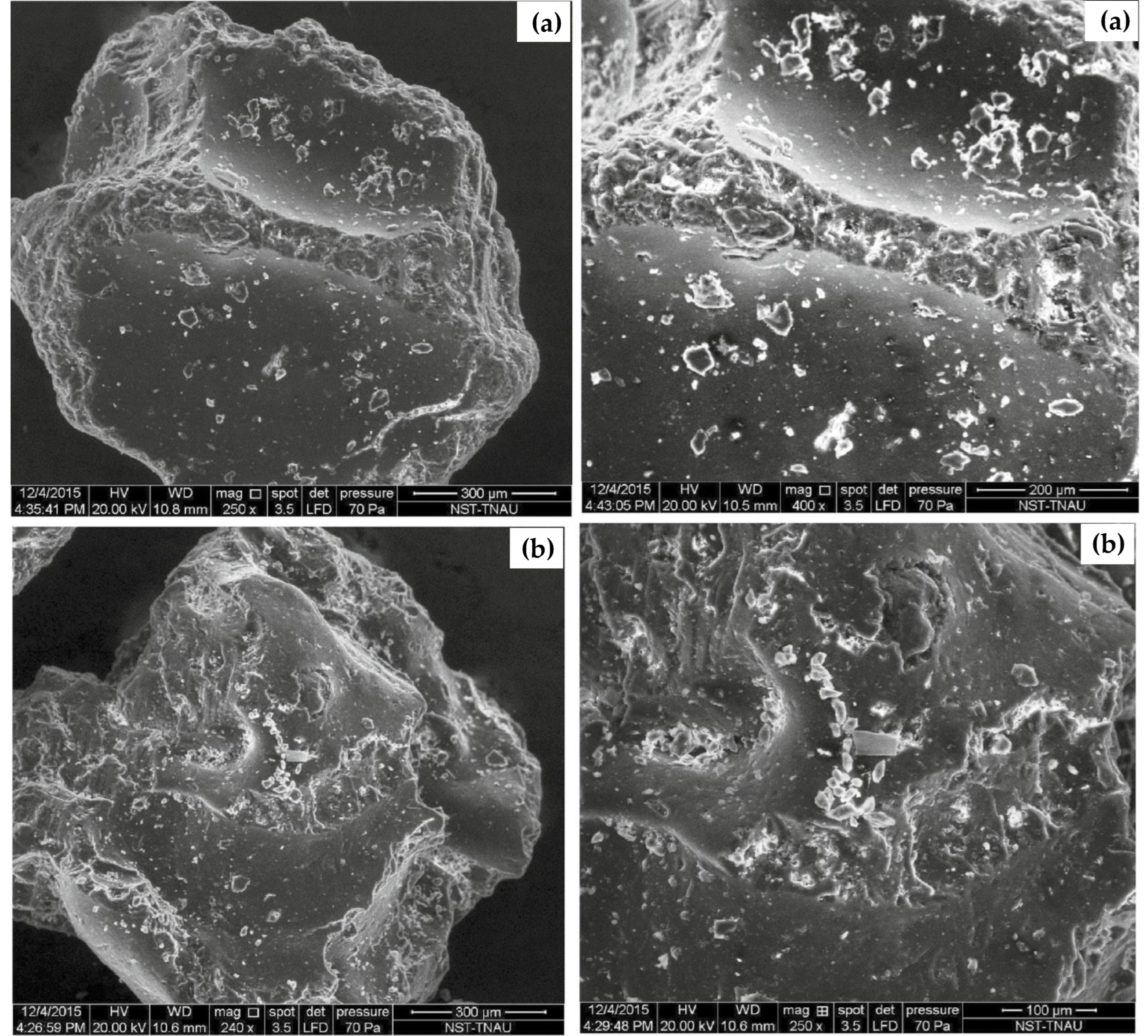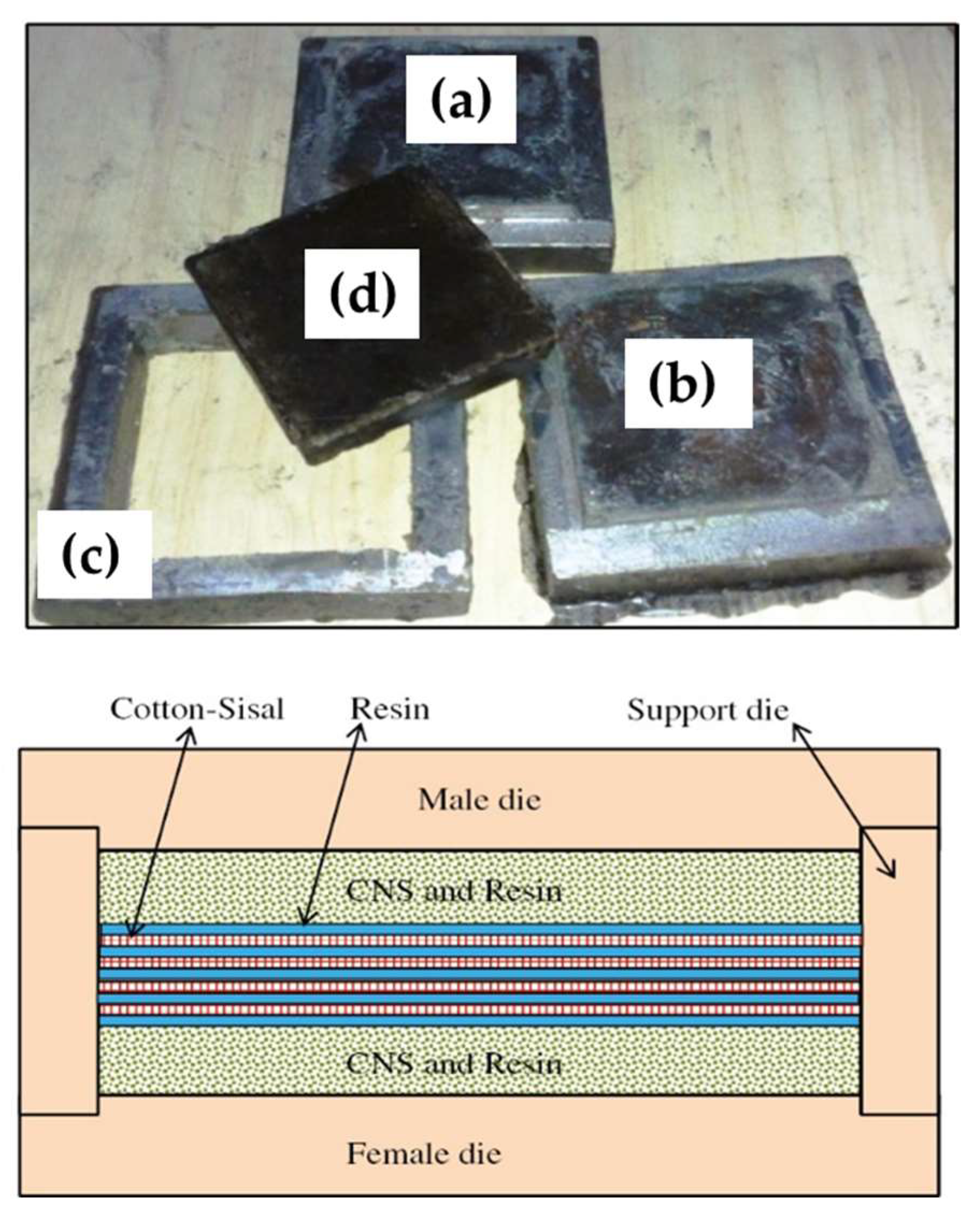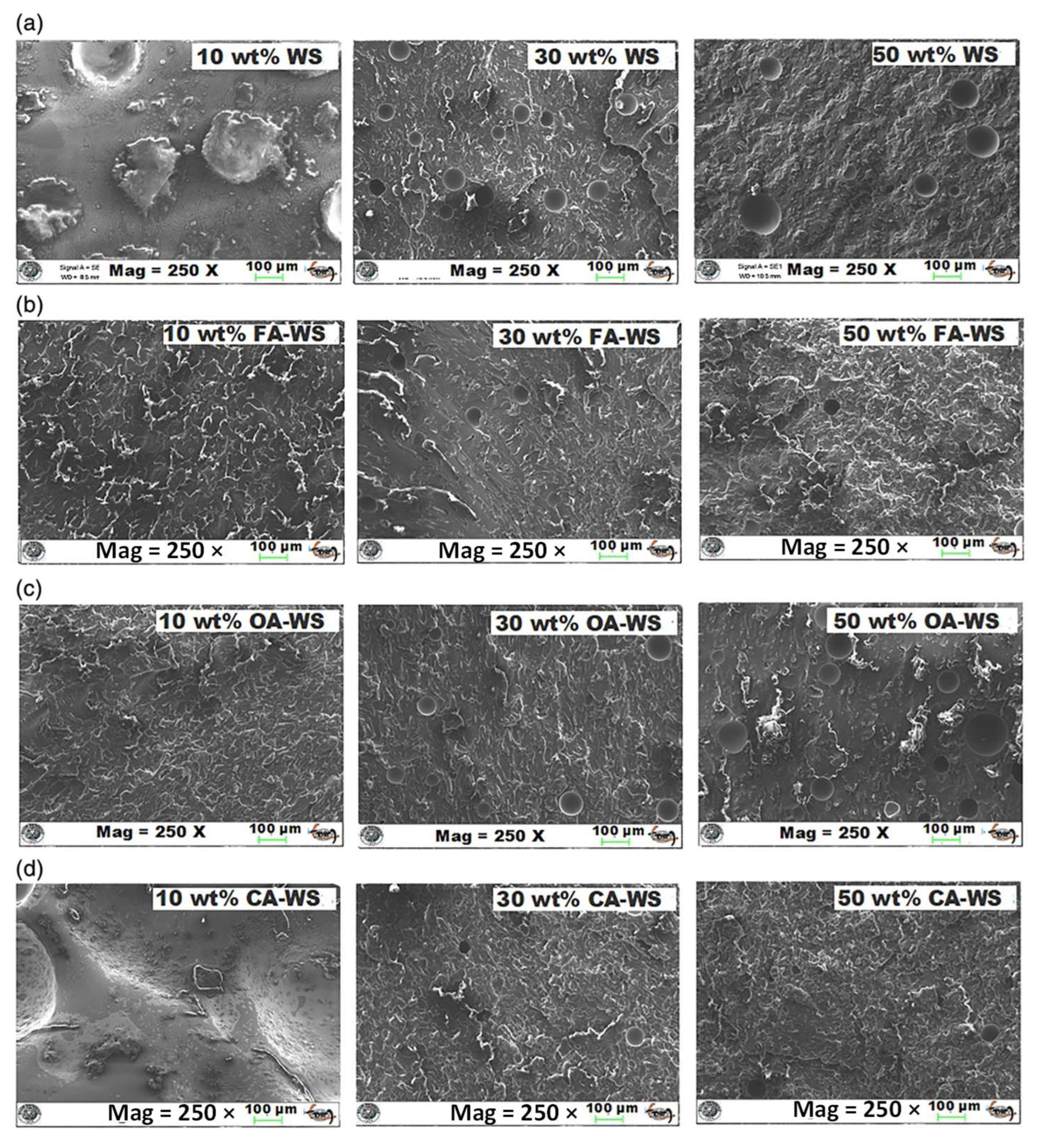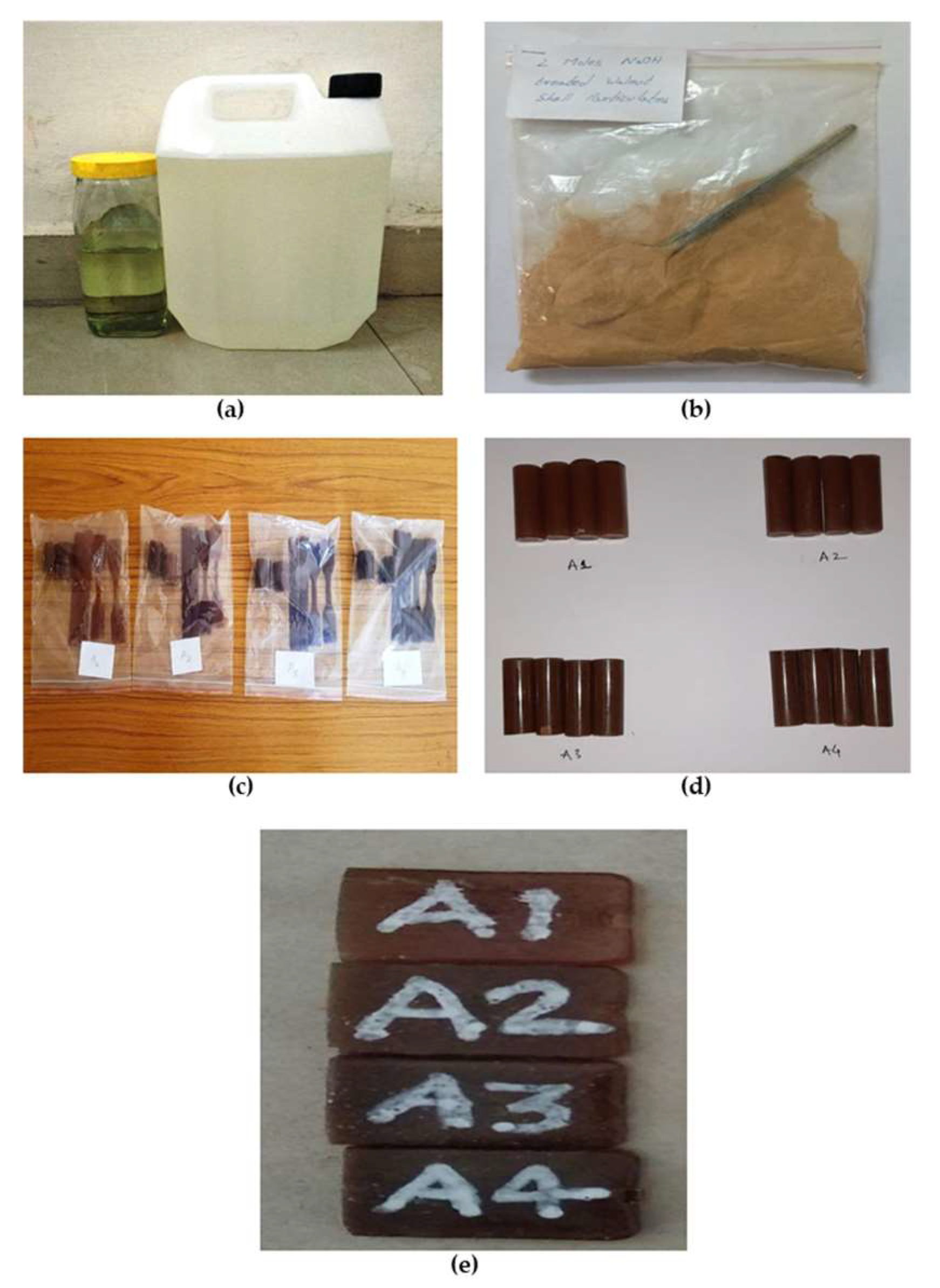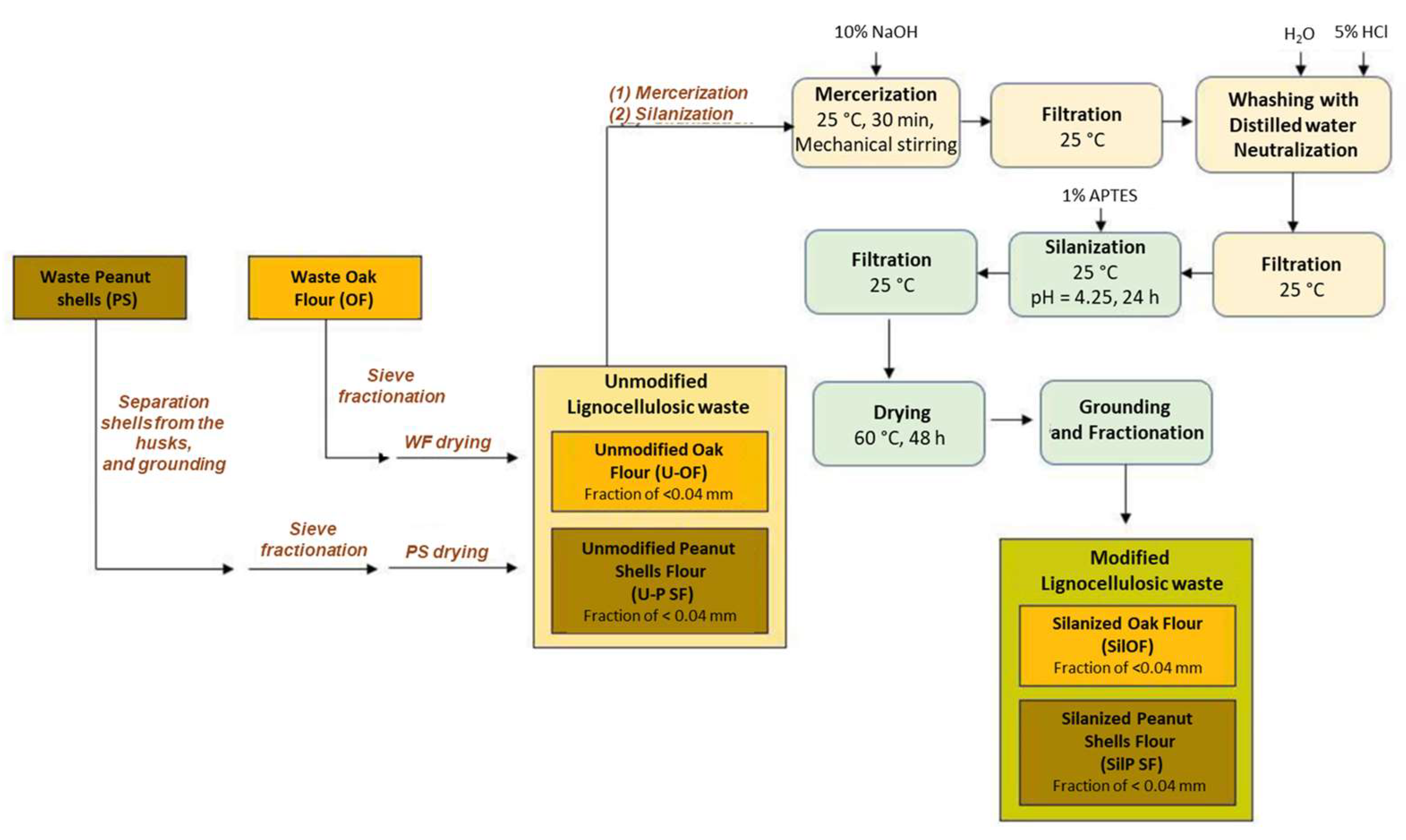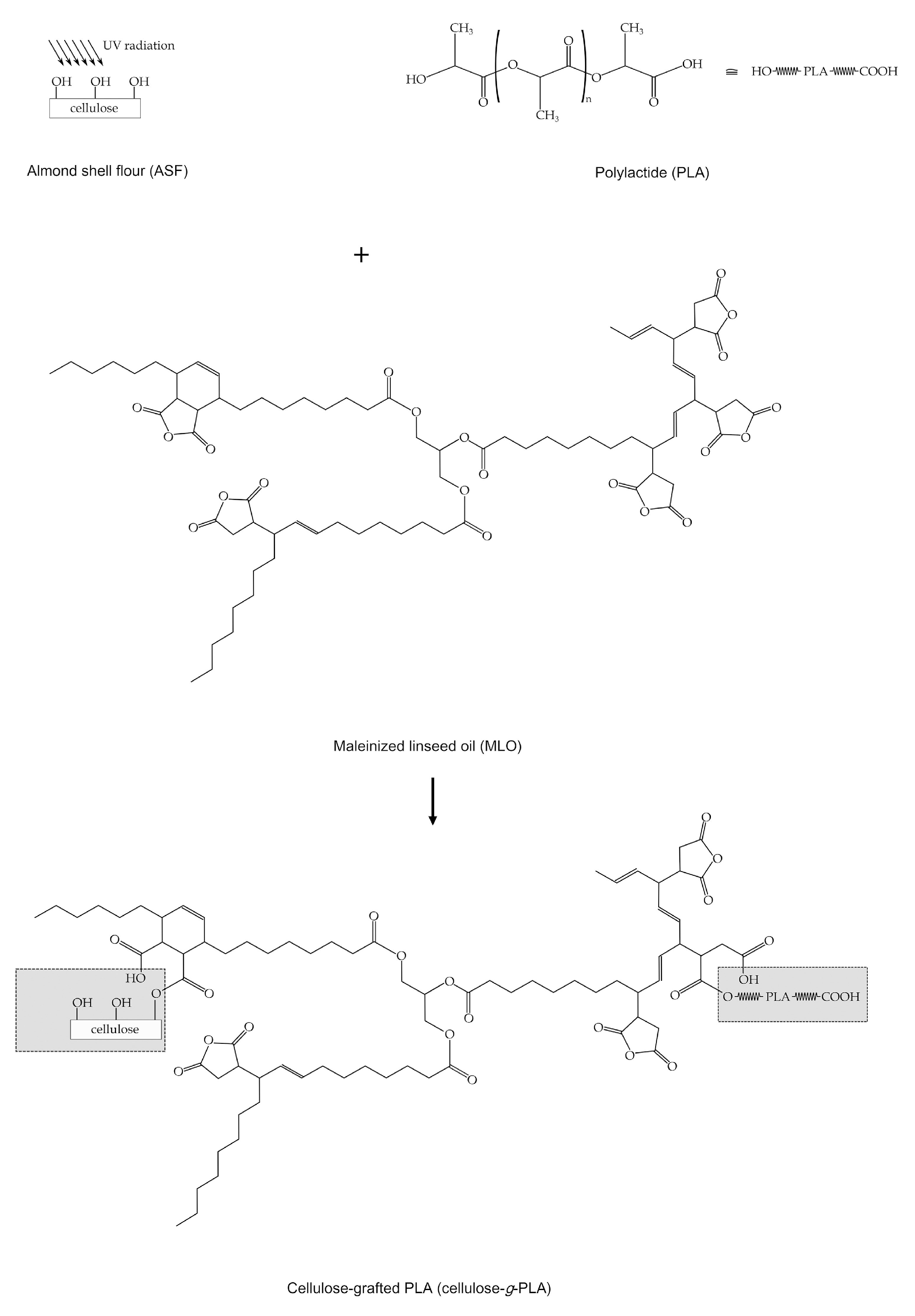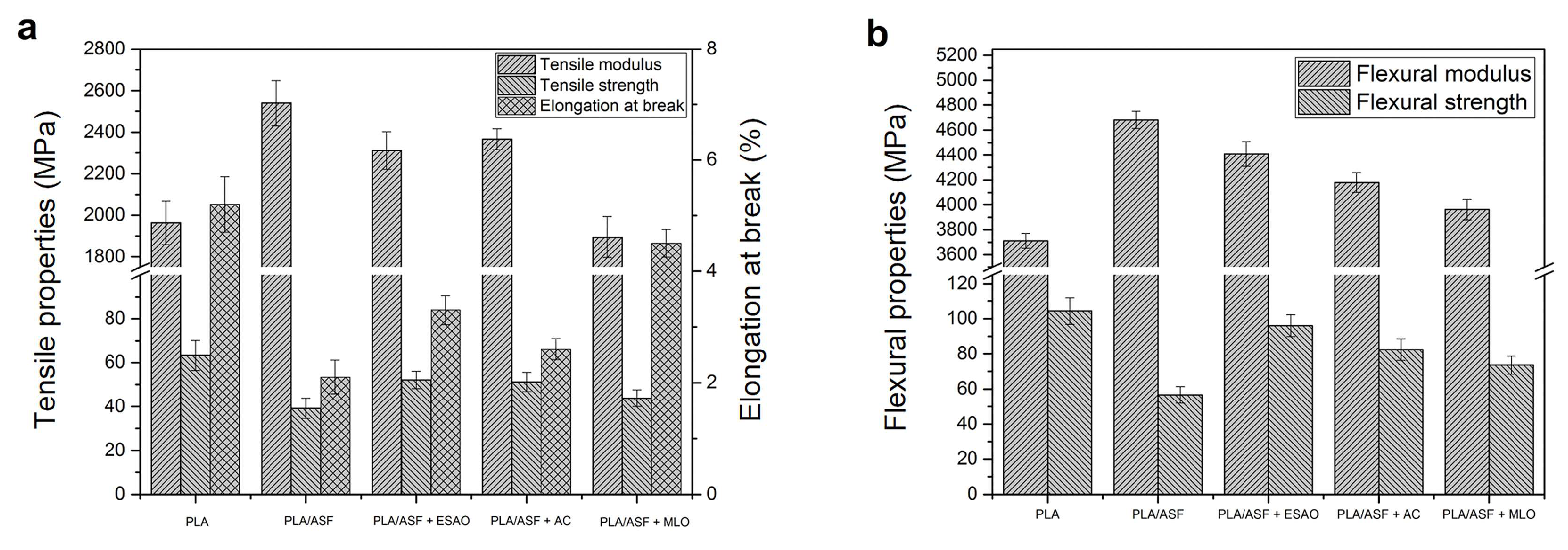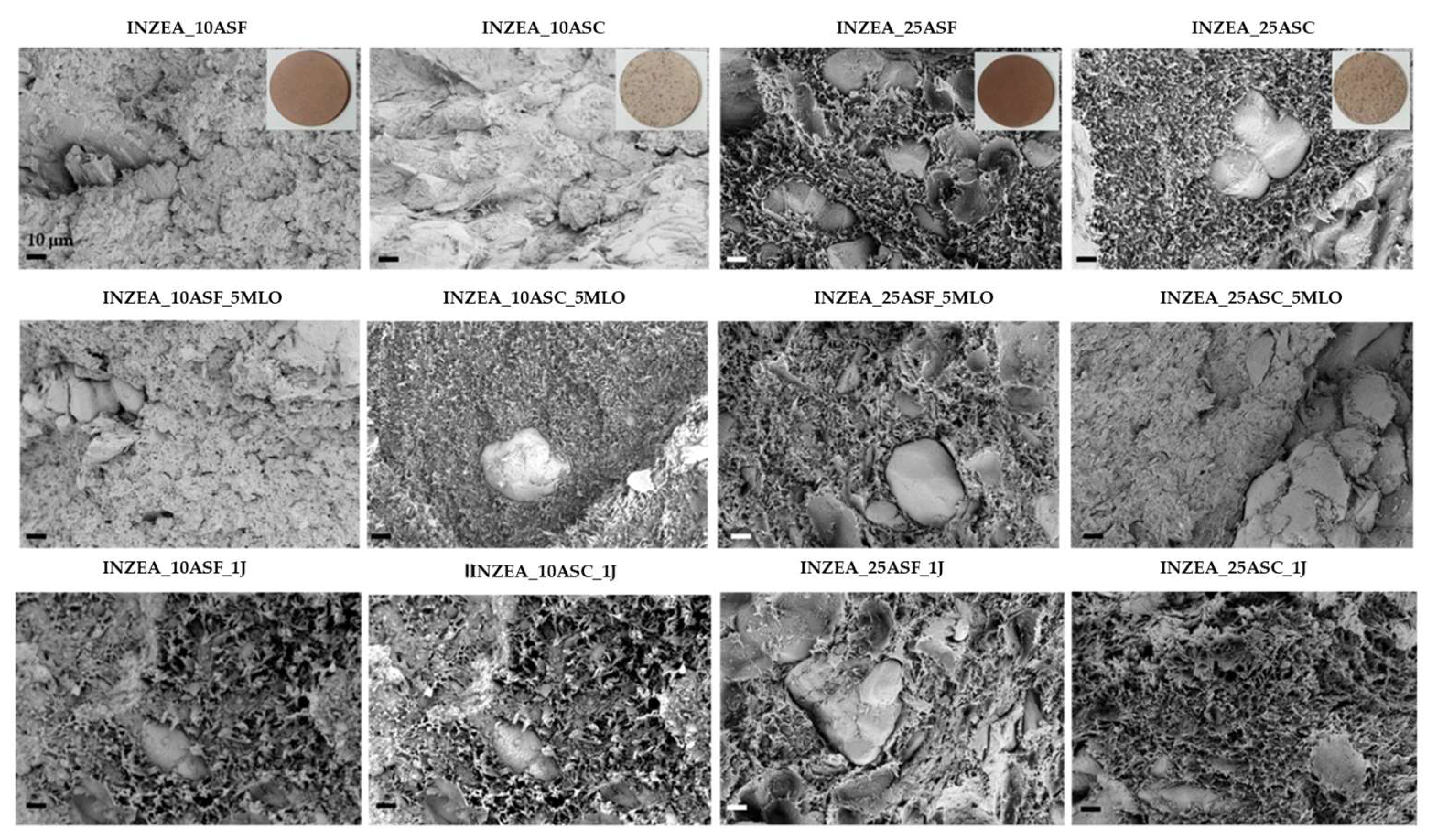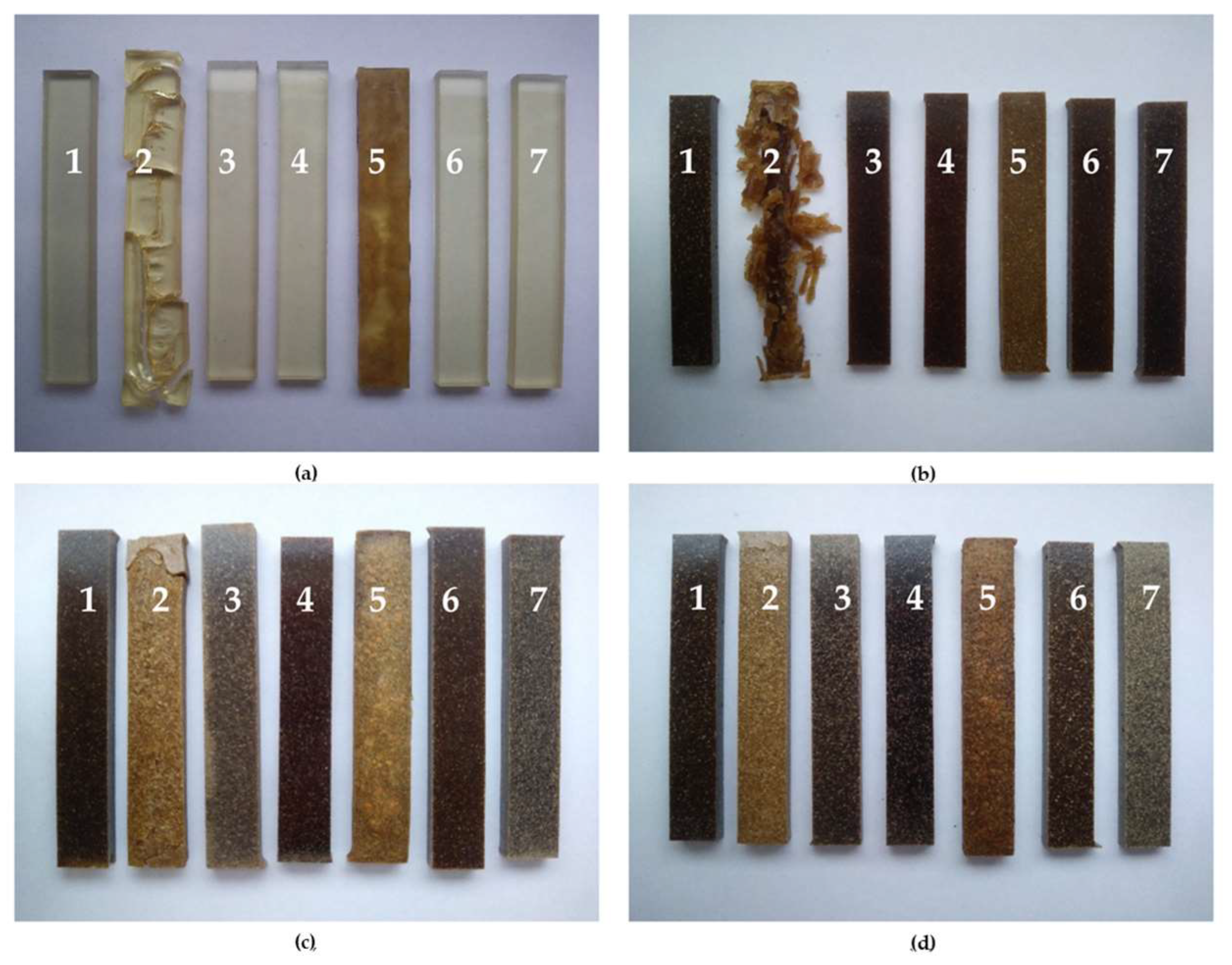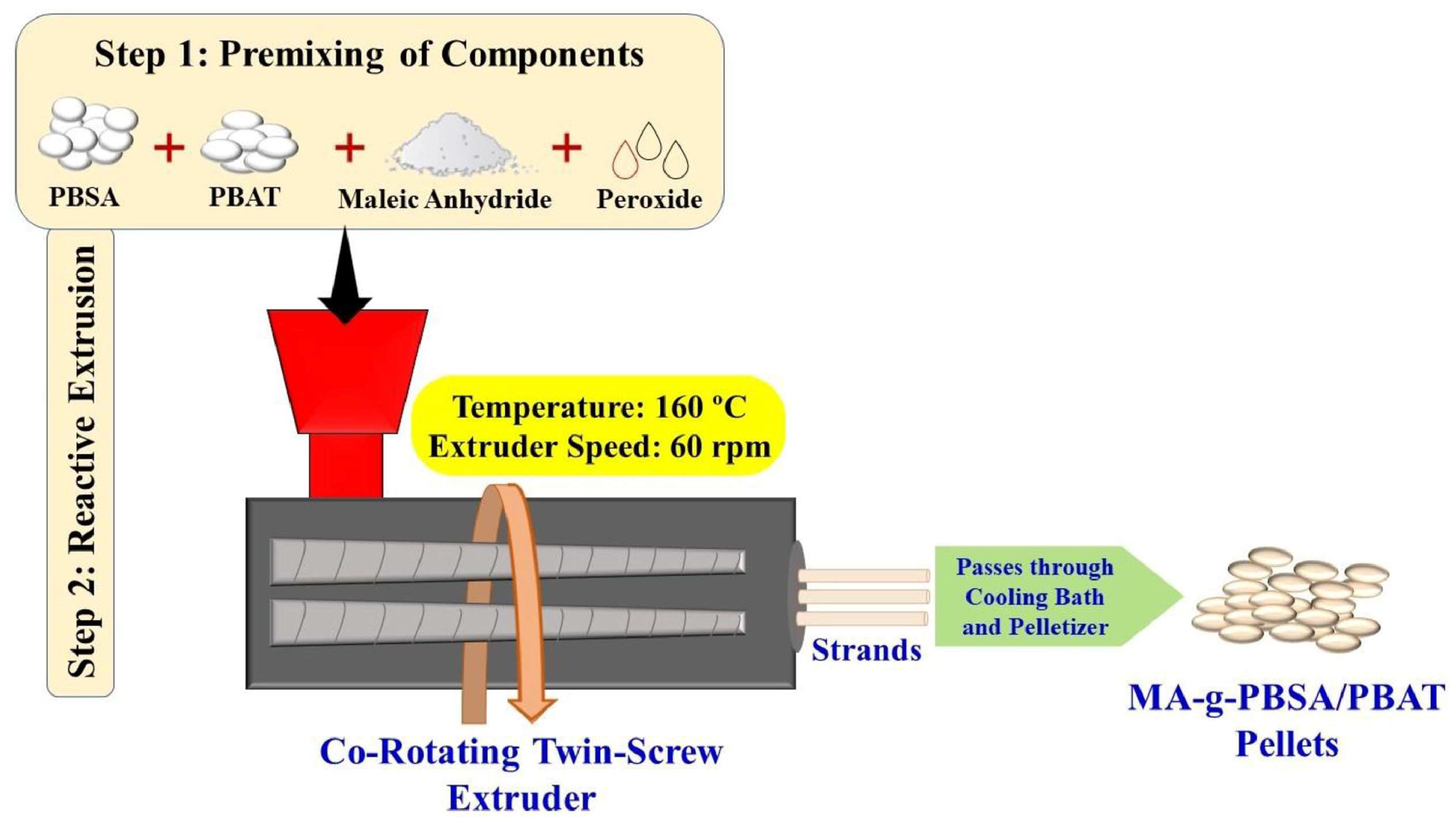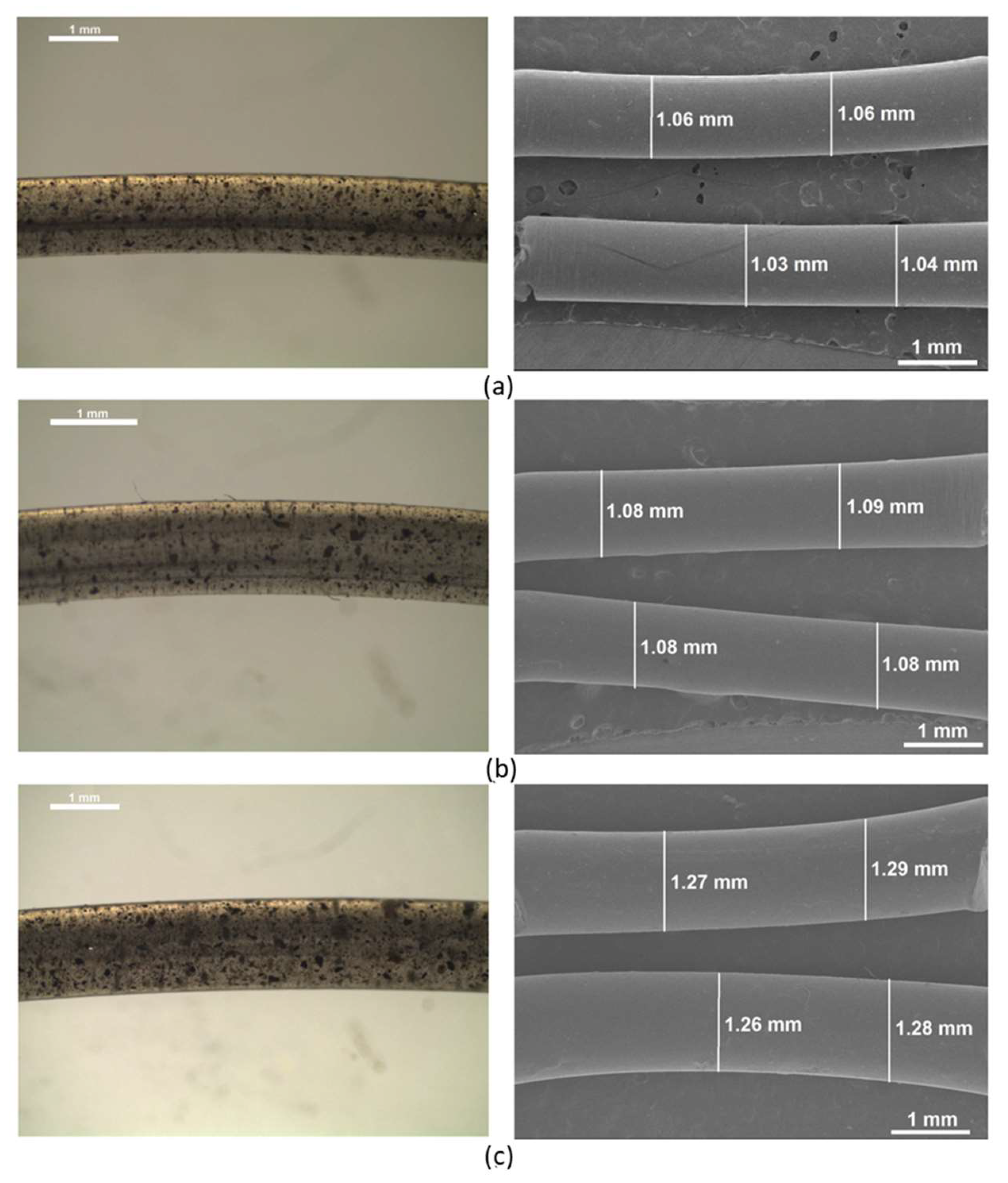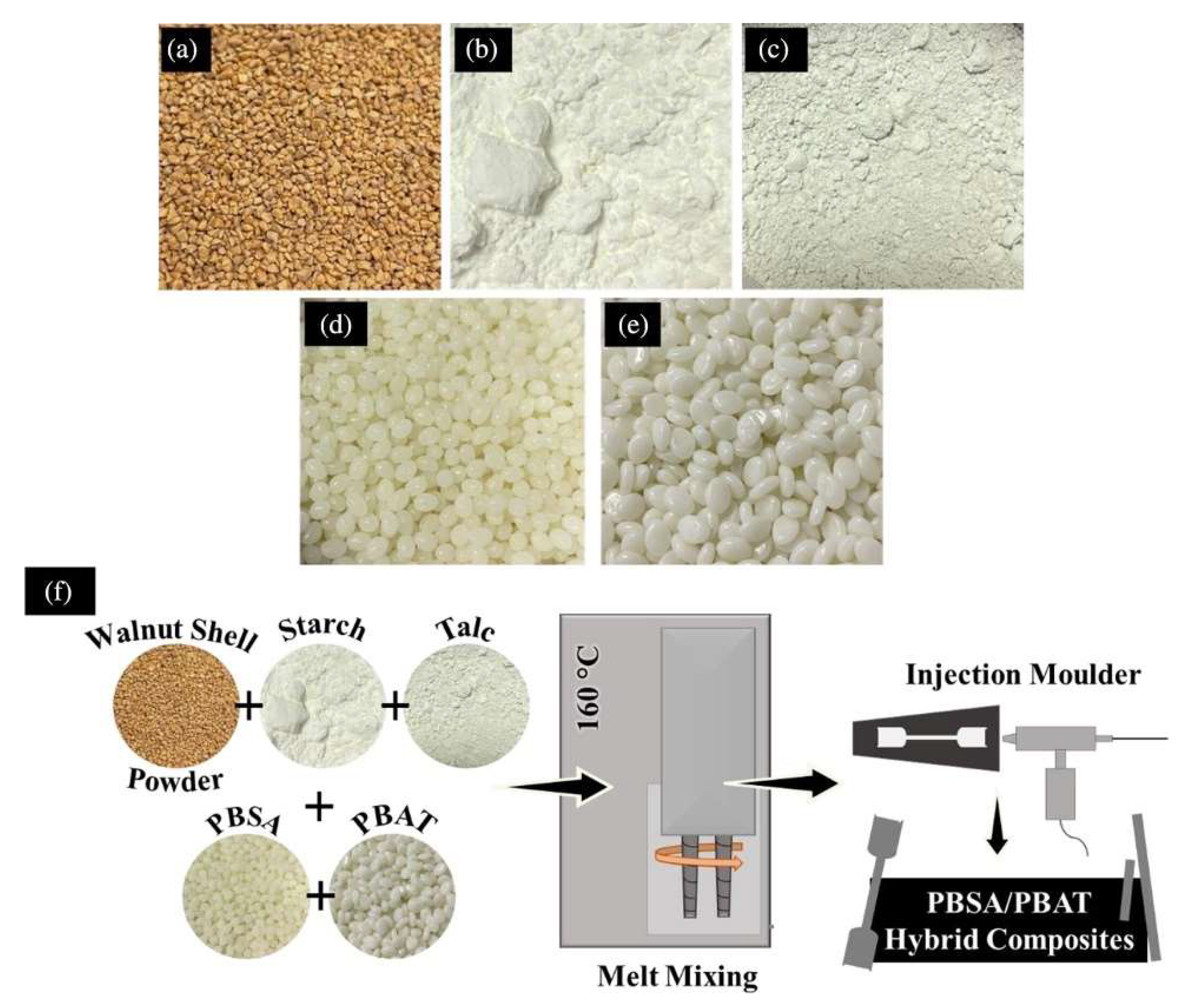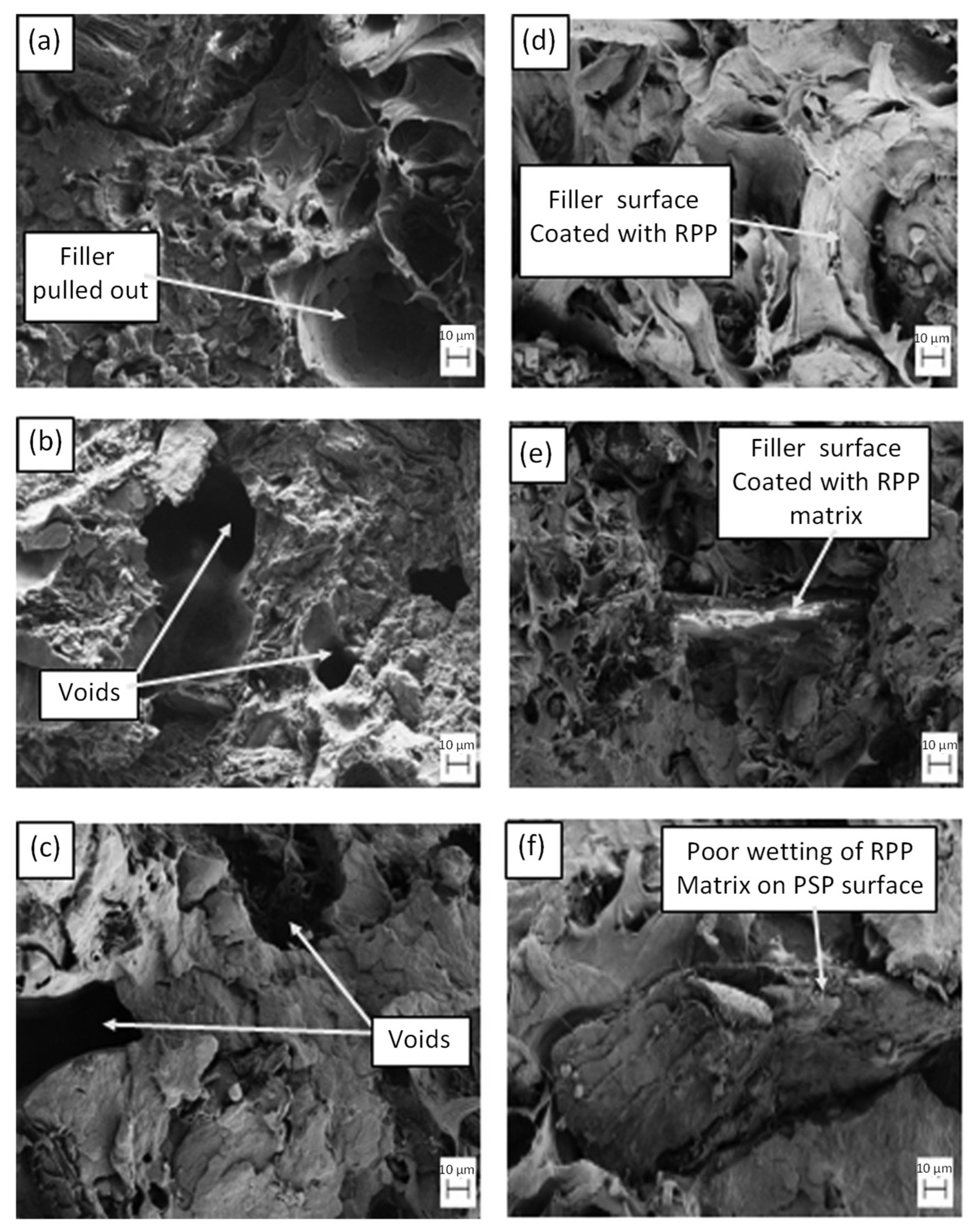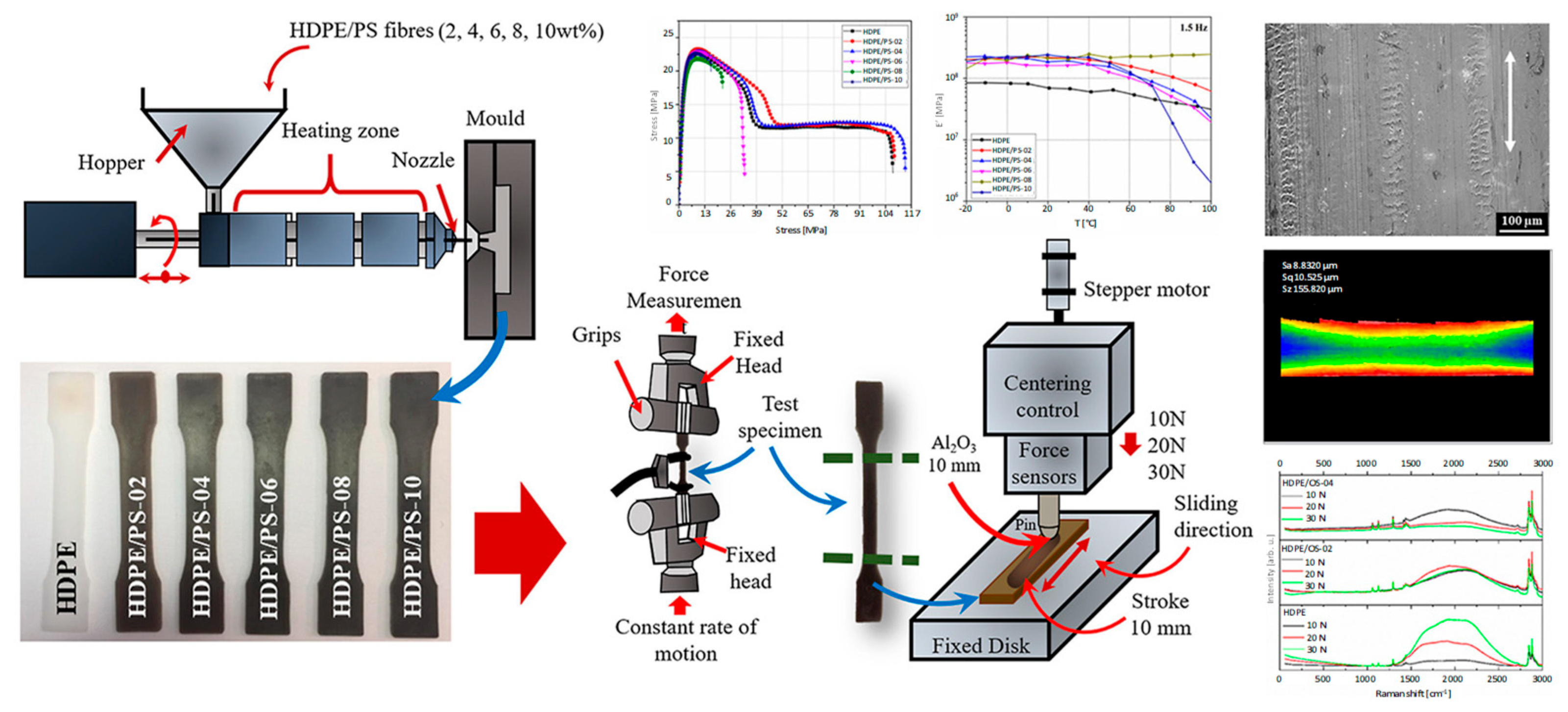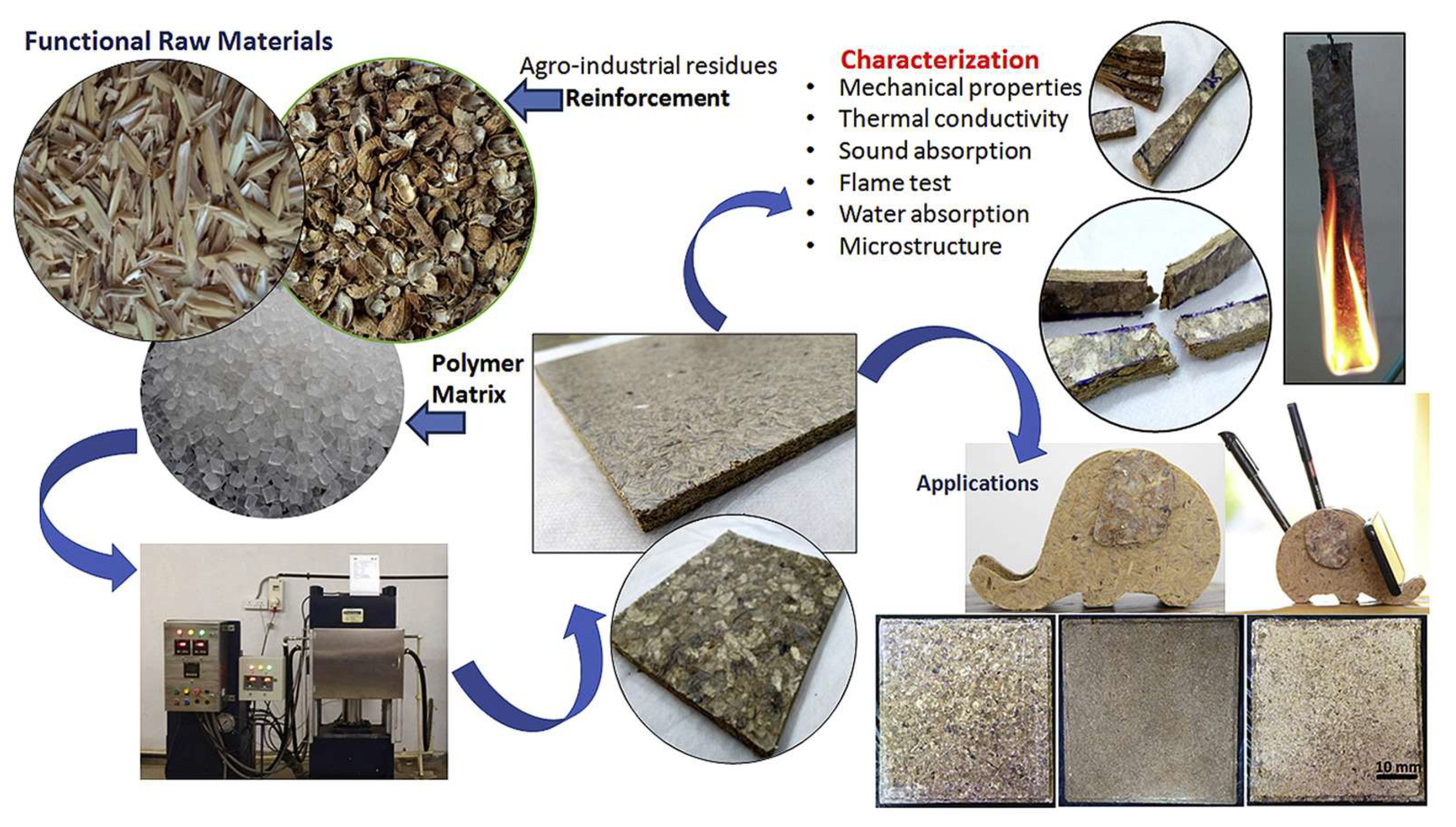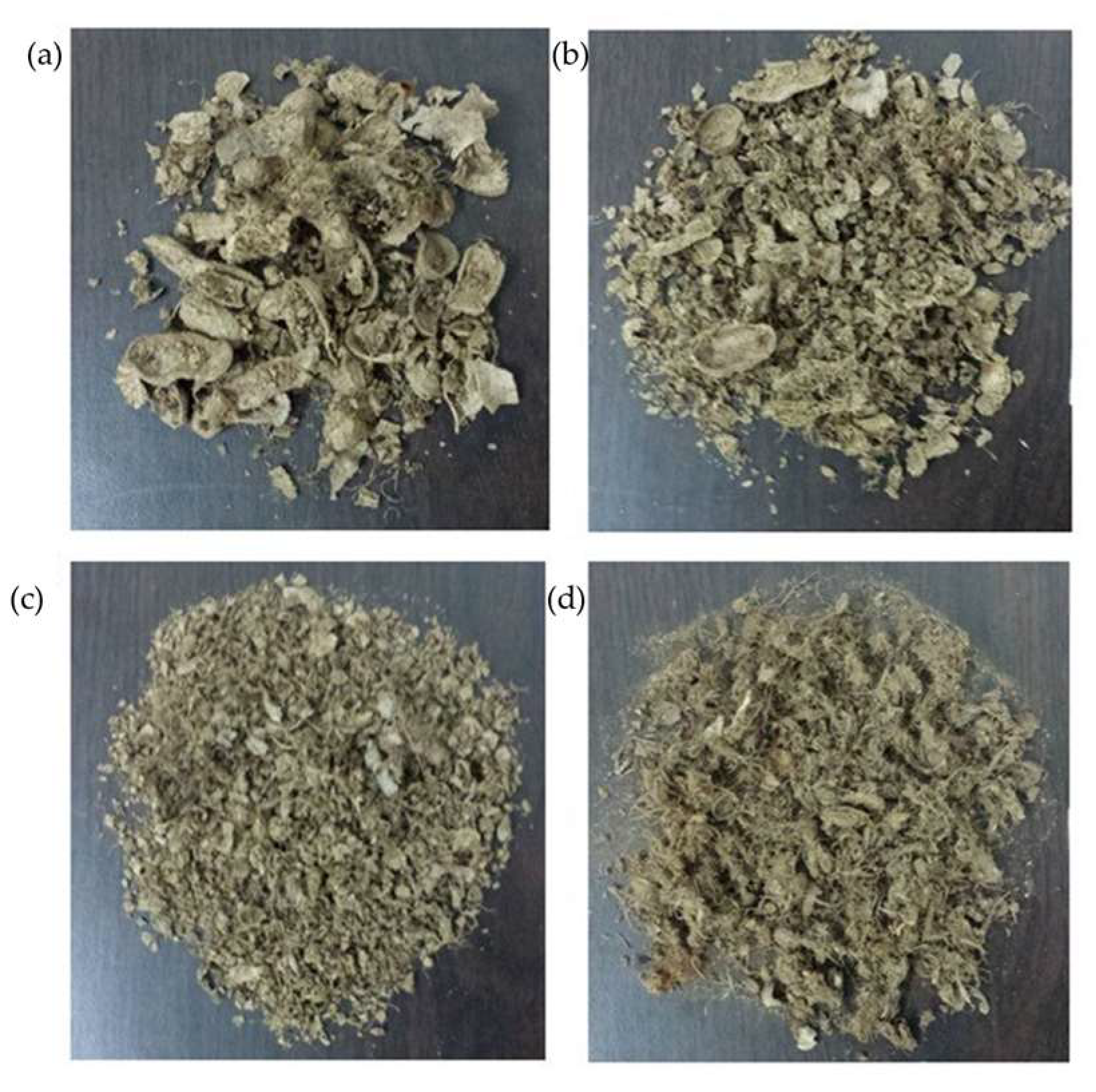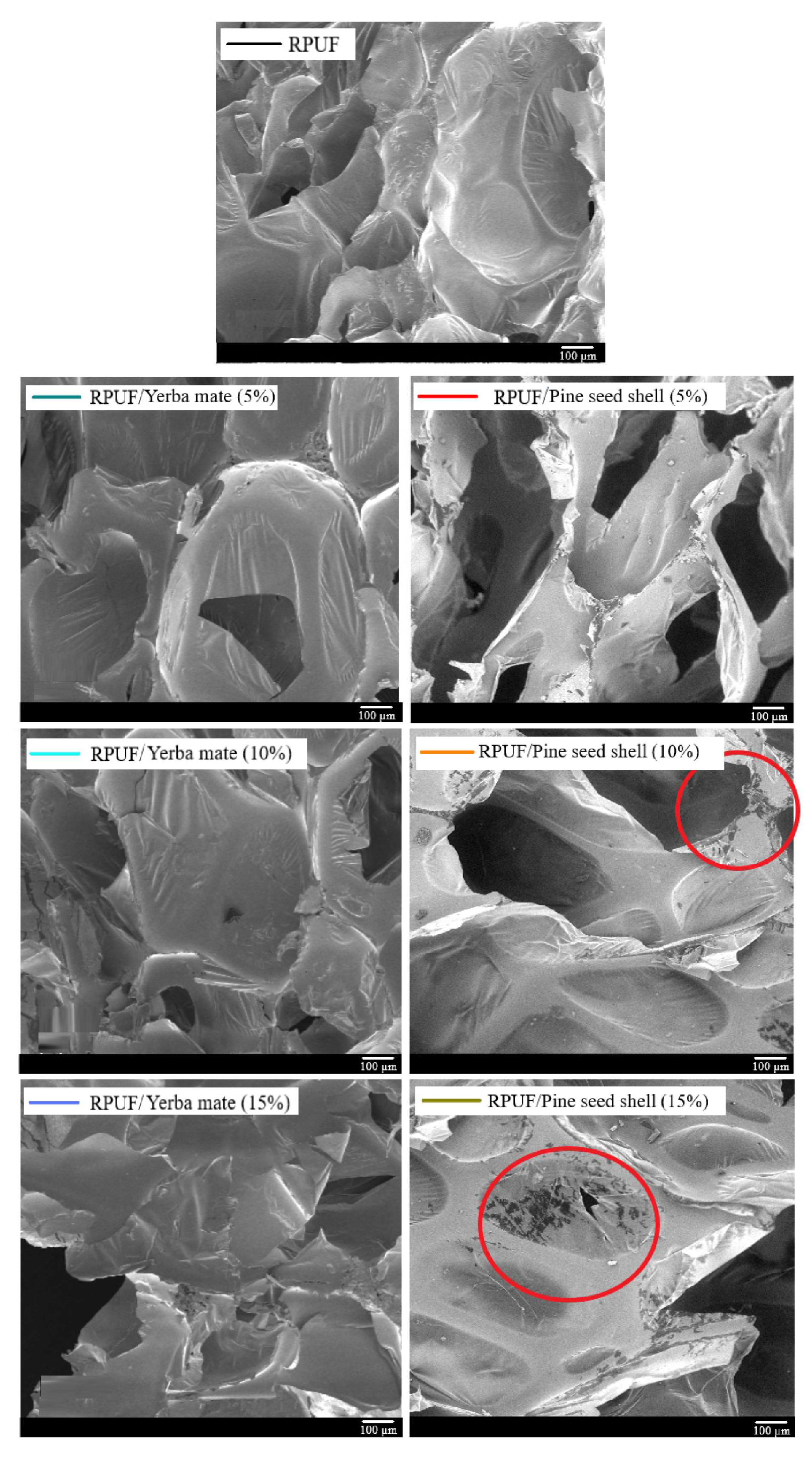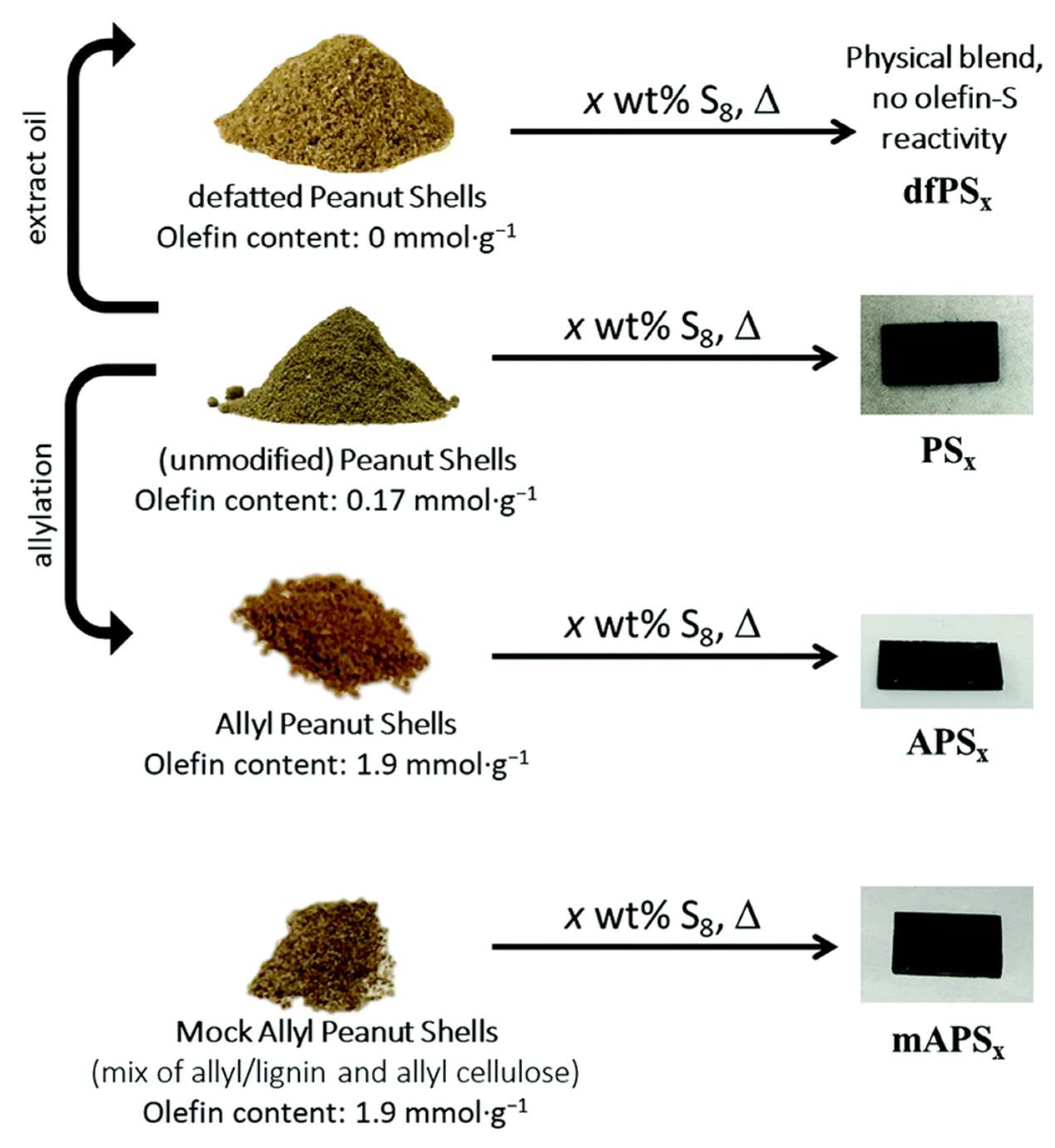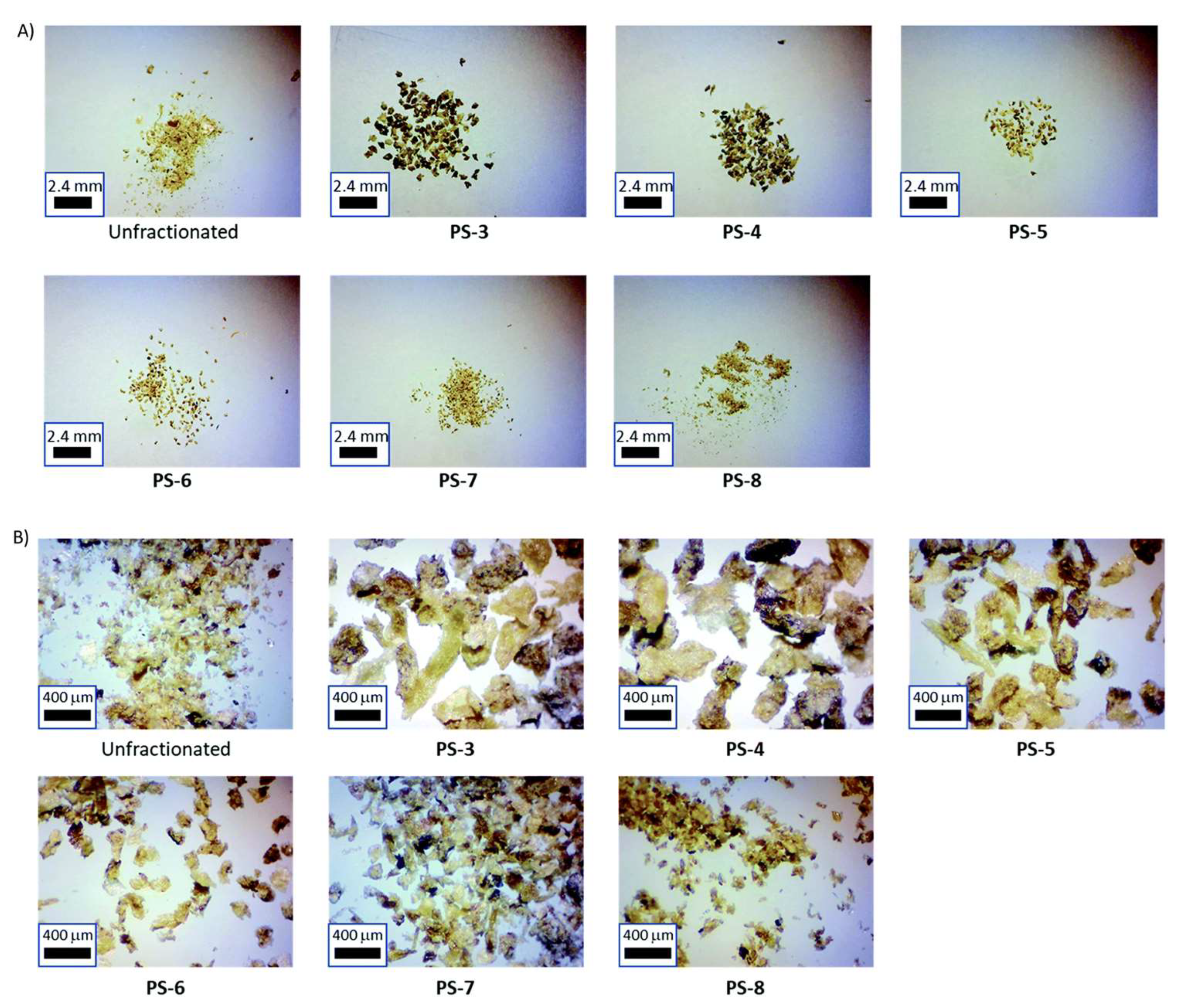3. Nutshells Reinforced Epoxy Resins
Epoxy resins were among the first commercially available thermosetting polymers, developed through chain-extension reactions between epoxide groups and curing agents. Their low shrinkage during curing along with excellent mechanical strength, chemical resistance, and dimensional stability, makes them a widely used material across industrial and structural applications. These qualities also make epoxy systems an ideal platform for exploring the incorporation of alternative, sustainable fillers [
35,
36,
37,
38,
39]. In recent years, nutshell waste has been investigated as a bio-based filler for epoxy matrices, offering opportunities to reduce environmental impact without compromising key material properties. This section reviews current research on epoxy-based composites incorporating nutshell fillers, with a focus on processing strategies, composite performance, and potential applications.
In the report by Salasinska et al. [
40], the authors investigated high proportions of ground walnut shells as a filler in Epidian 624 epoxy resin. The walnut shells were ground and sieved, resulting in a relatively uniform particle size distribution ranging from 32 to 125 µm. The natural filler, ranging from 20 to 50 wt. % was incorporated into the epoxy resin through stirring. The composites were allowed to cure for 7 days, after which their mechanical and thermal properties were assessed, along with morphological and chemical composition using electron microscopy and FT-IR. Chemical interactions between the walnut shell filler and the epoxy resin provide insights into how the filler affects the composite’s properties and performance. The addition of nutshells has been shown to improve the mechanical properties of the materials, particularly Young’s modulus and hardness. This fact is highlighted in
Figure 1b,d with significant improvements observed. The composite containing 50 wt. % walnut shell filler achieved the highest hardness value of 86.6 N/mm
2, compared to 76.6 N/mm
2 for the unmodified epoxy resin. However, establishing a clear correlation between filler content and hardness was difficult due to the walnut shells’ low inherent hardness and uneven dispersion in the epoxy resin. In addition to mechanical properties, the composites were evaluated for water absorption behavior, which is crucial for assessing their suitability for numerous applications. The epoxy resin matrix positively impacted the wettability of the organic filler, resulting in improved adhesion, as confirmed by microstructural analysis using scanning electron microscopy. While the study demonstrates improvements in hardness and adhesion with walnut shell fillers, the relatively low hardness of the filler limits overall performance enhancement. Further research could explore alternative fillers or surface treatments to improve these properties. Additionally, using walnut shells, an agricultural byproduct, as a filler represents a sustainable alternative to petroleum-based additives. However, the scalability of this approach and its environmental impact need further investigation.
Sathishkumar and coauthors [
34] investigated the tribological behavior of biodegradable composites made from epoxy resin and cashew nutshells. In this study, the authors explored the use of non-modified and modified shells (NaOH-treated), both were further used to prepare composites with filler ratios ranging from 5% to 40% by weight. In this context, the authors report that the NaOH treatment would isolate the strong amorphous filler, as depicted in
Figure 2. The composites were created using a compression molding process with a 2:1 resin-to-hardener ratio. The incorporation of the cashew shells and the resin was also performed by stirring, as in the report by Salasinska [
40]. The mixture was poured into molds, subjected to a pressure of 6.5 MPa for 8 h at room temperature, and then post-cured in an oven at 60 °C for one hour, as shown in
Figure 3. Tribological analyses were conducted according to ASTM G99 [
41] standards. The tribological performance of the composites varied due to inconsistent filler distribution and differing proportions of filler and resin. Increasing the filler content gradually reduced matrix regions during wear, leading to higher surface hardness values and reduced thermo-mechanical loading. Analysis showed that the friction performance improved with different filler contents and sliding velocities, and normal loads were applied. Composites with 30% by weight of cashew shells exhibited the lowest friction coefficients, which the authors attributed to an even filler distribution throughout the epoxy matrix and enhanced wear performance, resulting in lower specific wear rates. Overall, composites containing 30% cashew shells demonstrated superior wear and friction performance compared to other composites prepared. While these findings highlight the benefits of using cashew shells as fillers, further investigation into the consistency of filler distribution and its impact on tribological performance could provide additional insights.
Potadar and coworkers [
32] contributed further by testing epoxy composites reinforced with groundnut shells and coir fibers. In this study, groundnut shells were chemically treated with a 10% NaOH solution, thoroughly washed to remove any residue, then dried and ground to particle sizes of 1 mm, 1.5 mm, and 2 mm. The epoxy resin system used was Araldite LY-556 with HY-951 hardener in a 10:1 ratio, and it was mixed with groundnut shell particles at a 70:30 weight ratio, respectively, in a 12 mm thick mold. Tensile and flexural strengths were assessed for both groundnut shell and coir fiber composites. The results showed that tensile strength decreased with increasing particle size, while flexural strength decreased from 1 mm to 1.5 mm, then increased from 1.5 mm to 2 mm. Moisture absorption was negatively impacted in a similar manner to tensile strength, increasing steadily with particle size. Coir fiber composites followed the same general trends but exhibited higher mechanical strengths overall. Among all samples, the composite with 1 mm particle size performed best, displaying the highest tensile and flexural strengths and the lowest moisture absorption. This study highlights the influence of filler particle size on the mechanical and moisture resistance properties of natural fiber-reinforced epoxy composites; however, it does not explore bare epoxy resin properties compared to the composites with the filler preventing any meaningful direct comparisons.
A summary of mechanical and thermal properties from recent nutshell-reinforced epoxy and related composites is presented in
Table 1. Among studies using lignocellulosic fillers in PLA, epoxy, and polyester matrices, filler loadings between 10 and 30 wt. % consistently achieved mechanical gains, whereas higher loadings (>40 wt. %) often led to reduced performance due to agglomeration or insufficient wetting. In most cases, nutshell fillers outperformed mineral fillers like talc in terms of weight reduction and biodegradability, though they generally underperformed compared to glass fiber in absolute mechanical values. To better understand how chemical modifications influence performance across polymer matrices,
Table 2 presents a summary of surface treatment methods and their reported impact on mechanical and moisture-related properties.
Across systems where moisture resistance was measured, silane and acetylated treatments led to water uptake reductions between 30% and 60%, with silanization outperforming alkaline washing in nearly all epoxy-based composites. Comparing acid-treated and silane-treated walnut shell composites in epoxy matrices, citric acid-modified fillers improved tensile strength by 33% [
47], but silane-treated fillers yielded better consistency and reduced processing variability [
48]. While most studies reported gains from chemical pretreatment, the synergistic effect of dual treatments (e.g., alkali + silane) remains underexplored and merits systematic study under controlled conditions.
A study conducted by Ramamoorthi and collaborators [
42], aimed to prepare a hybrid natural fiber composite comprising sisal fibers and cashew nutshells as natural fillers,
Figure 4. These materials are inexpensive and low in density and toughness, allowing the preparation of cost-effective composites with enhanced mechanical properties. These materials were incorporated in epoxy resin LY 556 and hardener HY 951. Similarly to the previous study, they used a compression molding process to prepare the laminate composite and explored different filler ratios. However, in this study, the mechanical and morphological properties of the obtained composite were of main interest. This resin was pre-heated, followed by the addition of cashew nutshells, and the mixture was stirred manually. The composite was prepared in layers, starting by pouring the matrix resin with the nutshells and NaOH-washed-sisal fiber into the mold and finishing with coats of resin. The obtained material was cured in a compressive pressure of 1500 Psi for 24 h and post-cured at 70 °C for 2 h. As-prepared materials’ tensile, impact and flexural strengths were evaluated according to ASTM D3039-76 [
51], ASTM D256 [
52] and ASTM D790 [
53], respectively. The authors present evidence indicating that as the proportion of cashew nut dust rises, there is a nearly linear increase in tensile, compressive, and flexural strength compared to the composites prepared from sisal/epoxy. Flexural strength of bare epoxy resin was reported to be roughly 30 MPa, and the addition of 8 wt. % cashew nut dried shells increased flexural strength to nearly 40 MPa. On the other hand, maximum tensile strength was obtained at 6 wt. % filler. In morphological analysis, this trend was confirmed by the stronger interaction between the sisal/epoxy resin incorporating cashew nut dust as a filler through adhesion of the fiber and matrix system, which may cause improved strength properties of the composites. The long-term durability of the composites and potential applications need further evaluation. Examining other natural fillers and their combinations could provide insights into further improving composite performance.
Albaker et al. [
47] took a novel approach in 2021 using walnut shells as a filler for a bisphenol A-type epoxy resin (ER)-NPEK 114, aiming to create bio-based epoxy composites. Consistent with previous studies, the authors pretreated the shells with NaOH to remove non-cellulosic components. This study’s novelty lies in modifying the walnut shells using a variety of carboxylic acids, with multiple unique carboxyl groups being “anchored” to the surface of the walnut shell. Included in this study are specifically formic acid, oxalic acid, and citric acid, to evaluate their effects on the mechanical properties of the composites. This was performed by varying both the amount of filler and the number of carboxyl groups on the modified shells. FT-IR analysis revealed that the peaks related to C=O decreased after NaOH treatment but were regenerated following modification, indicating that carboxylic acids were bound to the surfaces of the walnut shells. The authors noted variations in the content of lignin, hemicellulose, and cellulose compared to raw walnut shells, which they attributed to acidification after alkali treatment. The chemically modified fillers were mixed with the epoxy resin in varying percentages (10–50 wt. %) to prepare specimens tested according to ASTM D 638 [
54] and cured at 60 °C in stainless-steel molds. SEM images provided insights into the compatibility of the raw and modified shells with the epoxy resin, as illustrated in
Figure 5. Acid-modified walnut shell particles were uniformly distributed up to 30 wt. % in the composites. The authors observed a distinct pattern in the citric acid-modified shells, which they attributed to enhanced interactions between the filler and the matrix, further supported by mechanical test results. The tensile strength values of the prepared composites ranged from 45 to 106 MPa for raw shells, from 70 to 97 MPa for formic acid-modified shells, from 79 to 117 MPa for oxalic acid-modified shells, and from 94 to 125 MPa for citric acid-modified shells. They found that enhanced mechanical properties and increased surface adhesion between the filler and the epoxy matrix correlated with a higher number of carboxyl groups. Despite the significant improvements in mechanical properties compared to other studies, the modification procedure is labor-intensive and time-consuming, which may be challenging for large-scale synthesis.
In the same year, Suthan and coworkers [
48] investigated the impact of silicon-coupling-grafted natural fillers on the properties of epoxy resin composites. Different from other reports, they have explored three types of natural fillers: groundnut shells, sawdust, and rice husk which were modified using silane in an acidic ethanol-water mixture. To support their proposed mechanism, FT-IR analysis was performed, and it revealed a peak at 1028 cm
−1, indicating the presence of siloxane moieties on the surfaces of the silane-modified natural fillers. The modification also introduced amino groups (–NH
2) on the filler surfaces, which could react further with the epoxy resin during composite preparation. The study evaluated the viscoelastic properties, fatigue behavior, and contact angle using ASTM D 4065 [
55], ASTM D 3479 [
56], and ASTM D 2578 [
57] standards. Among the natural fillers tested, silane modification significantly enhanced the performance of rice husk fillers compared to groundnut shells and sawdust, resulting in a storage modulus of 5.2 GPa and improved loss tangent values. The modified rice husk exhibited a maximum fatigue life cycle of 1310 cycles. Another key finding of this research is that the silane surface modification of the epoxy composites improved their resistance to absorption, as indicated by a higher contact angle, even after incorporating the natural fillers. Although the study shows that silane modification enhances the properties of rice husk fillers, it lacks a detailed discussion on the long-term durability and environmental impact of silane in the modification process.
Shejkar and collaborators [
58] investigated the use of NaOH-treated walnut shells as a filler for Lapox L-12 epoxy resin and tri-ethylene-tetramine as the hardener. Their study focused on incorporating the filler at lower percentages, up to 20 wt. %, and examined its physical, mechanical, and sliding wear behaviors. They found that increasing the load of walnut shell particles led to a decrease in density. Consistent with previous research, higher filler loads also resulted in increased water absorption. The authors evaluated the mechanical properties, specifically tensile, flexural, and compressive strengths in accordance with ASTM D638 [
54], ASTM D2344-84 [
59], and ASTM D695 [
60] standards. A pin-on-disk tribometer was employed to perform dry sliding wear tests, following ASTM G99 [
41] guidelines. All materials used and shaped composites prepared for testing in this study are shown in
Figure 6. The tensile strength of the composites increased with up to 10 wt. % walnut shell filler, beyond which it declined. In contrast, compressive strength improved with higher filler loads, rising from 82.5 MPa for the neat epoxy resin to 98.9 MPa for the composite containing 20 wt. % walnut shells. Key factors influencing sliding wear resistance (SWR) included walnut shell particle content, sliding velocity, sliding distance, and normal load. The study also confirmed the effective application of an artificial neural network (ANN) model for predicting performance across various test parameters, both within and beyond the established limits. Future research could explore the effects of varying treatment methods for walnut shells and assess the long-term durability and environmental impact of the composite materials.
In 2022, Pradhan [
61] reported the use of pistachio shells as a filler for epoxy resins, specifically Lapox B11, using 2-aminoethylethane-1,2-diamine as the hardener. This study focused on the tribological behaviors of the resulting composites, as friction and wear are critical parameters influencing material deterioration and energy dissipation. Composites containing 20 wt. % of filler demonstrated maximum abrasion resistance, achieving the lowest specific wear rate among all specimens tested. However, increasing the filler content to 30 wt. % resulted in decreased abrasion resistance due to insufficient support from the reduced epoxy resin matrix. The application of higher external loads and sliding velocities exacerbated wear, increasing thrust at the interface between the composite surface and abrasive grains. In summary, this study underscores the significant impact of filler content on the abrasive wear behavior of the composites. Future investigations into the influence of pistachio shells on other mechanical properties would be valuable for practical applications, and additional materials to enhance resistance to abrasion.
Ibrahem [
62] also examined the tribological behavior of epoxy resins reinforced with nutshell fillers. They prepared basalt-chopped fiber-reinforced epoxy hybrid composites using sunflower seed husk, peanut shell husk, and vegetable oils. The authors combined sunflower seed husk and peanut shell fillers with two types of vegetable oils, sesame and castor oil, in varying ratios from 0 to 20 wt. %. They suggested that the inclusion of vegetable oils enhances the tribological performance of the composites through self-lubrication generated by oil migration from the filler. Notably, the study highlighted that peanut shell husk emerged as the most effective filler. The incorporation of 10–15 wt. % peanut shell significantly reduced both the friction coefficient (from 0.92 to as low as 0.23) and wear rate (down to 2 × 10
−6 g/N·m), while also maintaining or improving hardness values depending on the oil and filler content. Furthermore, sesame oil was found to enhance wear resistance more effectively than castor oil, while castor oil demonstrated superior performance in friction reduction compared to sesame oil. Another critical parameter evaluated in this study was hardness, with the authors observing that higher oil content resulted in lower hardness in the composites. Overall, this research suggests that epoxy hybrid composites containing 10 wt. % peanut shells and 10 wt. % vegetable oil may be suitable for tribological applications requiring low friction coefficients and high wear resistance.
Many studies have demonstrated that a significant amount of filler is used in polymer applications. However, only a small portion of them take advantage of material streams that are recycled. In a comprehensive study by Zamani and coworkers [
63], walnut shell, hazelnut shell, mussel shell, and their respective chars are used as fillers for three types of epoxy resins. Unlike other studies that typically focus on mechanical properties, this research emphasizes water sorption and thermal and fire resistance. The fillers were mixed with epoxy matrices at loadings ranging from 10 to 50 wt. % via mechanical stirring. As expected, the mussel shell-filled composites exhibited the lowest water sorption among the series tested, even when compared to the pure matrices, which is predictable due to the low solubility of calcium carbonate in water. When using plant-based fillers, it was noted that higher loadings resulted in increased water sorption. However, hazelnut shells exhibited an unexpected behavior, with higher absorption at 30 wt. %. This phenomenon can be attributed to the hemicellulose content and the availability of hydroxyl groups. Water absorption was also evaluated in composites made from the chars of walnut and hazelnut shells. Although these composites showed slightly higher water absorption than the pure resin, their values were approximately 1.5 to 2 times lower than those of the walnut and hazelnut shell composites. Regarding flame retardancy, the authors used the limiting oxygen index value. The tests indicated that all mussel shell and char composites were filled to 50 wt. %, which indicates that these materials are non-combustible. While the composites made from walnut and hazelnut shells showed the greatest water sorption, their absorption rates stayed below 2%. As a result, all the composites created could be effective substitutes for conventional wood products and flooring. Using these composite materials can help address wood shortages in certain regions while providing various environmental and socio-economic advantages.
Sienkiewicz and Czub [
33] offered a comparative study of the effect of oak wood waste and peanut shells on the properties of Epidian 6 epoxy resin composites cured with isophorone-diamine. In their study, the authors prepared the composites at 5 and 10 wt. % of the fillers and compared the influence of a two-stage modification to improve compatibility between the fillers and the resin on both types of fillers. As for the filler preparation, both oak wood and peanut shells were ground and sieved to obtain particle sizes < 0.04 mm, and dried for 48 h at 60 °C. The fillers were then subjected to the two-stage chemical modification-first a mercerization process using 10% NaOH solution followed by silanization with 3-aminopropyltriethoxysilane. Once the fillers were prepared, the authors added them to the epoxy resin in different ratios and poured them into Teflon molds to cast shapes for mechanical properties evaluation, as summarized in
Figure 7. The authors observed that composites comprising 10 wt. % of fillers had poorer mechanical performance, with the exception of the material prepared by using unmodified oak flour. These composites presented the highest compressive strength of the series prepared within this study, despite the observation that the modification indeed improved compatibility between both the polymer and the filler. When compared to the pure resin, the mechanical properties of the materials prepared from oak filler at 5 wt. % presented slightly higher values of flexural strength and a 2-fold increase in impact strength, 73.8 MPa and 15.82 kJ/m
2, respectively. Peanut shell flour composites showed less strength when compared to the same composition when replaced with oak wood flour, which the authors attributed to a higher impurity content, affecting the silanization process. In addition to the information that the authors provided, it would be interesting to evaluate how the material would perform if the particle size was increased/varied; it is also important to highlight that these composites could be very useful as construction materials, after further characterization and longevity studies.
Sivakumar [
64], in 2023 investigated the tribological properties of epoxy resin composites reinforced with ground walnut shells, focusing on their frictional and adhesive wear behavior. The composites were prepared by varying the walnut shell content from 0 to 10 wt. %, using HSC 7400 epoxy resin and HSC 8210 hardener. To enhance the compatibility between the matrix and the filler, sodium hydroxide was used to treat the walnut shells, following a method similar to previous studies mentioned earlier in this review. The results revealed that the addition of walnut shell fillers improved the mechanical properties of the epoxy matrix, with lower specific wear rates and reduced volume loss observed at smaller filler loadings. Composites reinforced with 2–4 wt. % of alkali-treated walnut shell fillers exhibited superior wear resistance, lower volume loss, and enhanced interfacial bonding, as compared to untreated or higher-loaded (8–10 wt. %) systems, where filler agglomeration often led to stress concentration and premature failure. Under dry sliding, the coefficient of friction (COF) was substantially reduced in treated composites (as low as ~0.3) versus neat epoxy (>0.6), indicating improved load-bearing capacity and reduced asperity interlocking. Under wet conditions, the specific wear rate was significantly lower compared to dry and hot contact conditions, suggesting that environmental factors could influence on their properties. From a thermal standpoint, increased testing temperatures (30–60 °C) caused volume loss in plain epoxy to rise steeply, whereas composites with treated walnut shell maintained greater dimensional stability, due in part to the formation of thermo-protective transfer layers. This demonstrates that mechanical durability is not only preserved but enhanced under moderate thermal and tribological stress. The hardness and structural integrity of the treated composites also benefited from improved filler-matrix compatibility, enabling the material to better resist surface plastic deformation and microcracking during extended sliding wear. These findings highlight the mechanical advantages of incorporating surface-modified walnut shell powder into polymer matrices, particularly for applications requiring abrasion resistance, thermal resilience, and environmentally conscious material engineering.
That same year, Gorar et al. [
65] developed environmentally friendly composites by reinforcing bio-benzoxazine and epoxy copolymers with alkali-treated pine nutshell particles. The bio-benzoxazine or poly(VB) was synthesized through the reaction of vanillin and furfurylamine, which was then copolymerized with E51 epoxy resin. The alkali-treated pine nutshell particles were first dispersed into the poly(VB) monomer, followed by blending with epoxy, forming composites with 0–40 wt. % filler content. The alkali treatment of the particles was found to improve their adhesion to the matrix and enhance their dispersion within the composite, as shown in previous studies. Compared to the neat copolymer, the composites showed a slight increase in glass transition temperature (2 °C). Mechanical testing revealed significant enhancements in flexural strength (135.6%), modulus (41.1%), and impact strength (64.5%). Dynamic mechanical analysis showed a 77.6% increase in storage modulus for the 40 wt. % nutshell particle composite. Dynamic mechanical analysis indicated that the composites exhibited a higher storage modulus, which increased by 77.6% compared to the unfilled copolymer. Some mechanical properties are summarized in
Table 3. Thermogravimetric analysis confirmed the thermal stability of the composites, showing that they remained resistant to degradation at lower temperatures. Based on the limiting oxygen index, both the copolymer and the composites were classified as self-extinguishing. Additionally, finite element analysis simulations were conducted to further validate the experimental results, showing that the composites reinforced with pine nutshell particles performed better than the unfilled copolymer. These findings suggest that the copolymerization of bio-benzoxazine with epoxy resin can enhance the material’s thermal stability, making it suitable for applications where high-impact resistance is required.
Ogah and coworkers, in 2024, ref. [
66] prepared epoxy composites incorporating 5–35 wt. % Bambara nutshell (BNS), a native African agricultural residue, and evaluated their physical, mechanical, and thermal properties. Water absorption increased with filler content due to the hydrophilic nature of BNS and associated swelling, while density decreased from 1.15 g/cm
3 (neat epoxy) to 1.05 g/cm
3 at 35 wt. % BNS. Thermogravimetric analysis showed reduced thermal stability with increasing BNS, though a slight improvement at 20 wt. % suggested better matrix–filler adhesion. DSC results revealed a general increase in
Tg compared to the control (125.63 °C), indicating restricted chain mobility, with exceptions at 10 and 35 wt. %. Mechanical properties improved up to 15 wt. % filler: tensile strength rose from 23 MPa (5 wt. %) to 40 MPa, modulus from 80 MPa to 155 MPa, flexural strength reached 65 MPa, and impact strength peaked at 50 J/m. Above 15 wt. %, performance declined due to filler agglomeration and weak interfacial bonding. However, Rockwell hardness increased consistently, reaching 225 at 35 wt. %, attributed to the accumulation of hard filler at the surface.
Narayanan and Muthukumaran [
67] developed eco-friendly epoxy composites reinforced with silane-treated corn husk fiber and biofillers—either coconut shell powder (CHCE) or areca nut powder (CHAE)—to enhance mechanical, thermal, and wear performance. All composites contained 40 vol% fiber and 0–5 vol% filler, with CHAE3 (3 vol% areca nut powder) showing optimal performance. Compared to unfilled CHAE0, tensile strength increased from 65.42 MPa to 88.88 MPa, flexural strength from 137.3 MPa to 175.89 MPa, and impact energy from 3.9 J to 5.3 J. Hardness also rose, reaching 85.8 Shore-D at 5 vol% filler. CHAE composites demonstrated superior wear resistance (down to 0.07 g wear loss) and reduced COF (0.28), alongside a notable increase in fatigue life (35,420 cycles at 25% UTS). Thermal stability improved progressively, with CHAE5 achieving 94% weight retention at 384 °C. However, increasing filler content also led to higher water absorption and lower thermal conductivity due to the hygroscopic and insulating nature of the fillers. SEM confirmed improved microstructure in CHAE composites highlighting uniform filler dispersion and reduced matrix cracking. These results suggest the promising potential of silane-treated agro-waste biofillers for high-performance, sustainable composite applications.
In the same year, Pezzana et al. [
68] reported the high-temperature vat photopolymerization 3D printing of fully bio-based composites using epoxy linseed oil (ELO) and epoxy soybean oil (ESO) as matrices, reinforced with bio-derived fillers such as walnut shell (WS), tagua, and hemp powders to increase overall biocontent and enhance performance. These natural fillers were incorporated into the vegetable oil-based epoxy resins in various particle sizes, specifically, walnut shell powders with mesh sizes 200 and 325 (WS200 and WS325, corresponding to particles mostly below 75 µm and 45 µm, respectively), to study the effect of filler fineness on composite properties. UV-curing at 100 °C significantly improved epoxy conversion (>90%) and reduced gel time (e.g., from 16 s at 25 °C to 4.5 s for ELO), enabling efficient printing of complex geometries
Figure 8 shows the cationic UV-curing chain-growth mechanism, highlighting the chain-transfer interactions between the polymer matrix and the filler. Thermo-mechanical testing revealed that filler addition enhanced stiffness and strength, e.g., Young’s modulus increased from 3.3 MPa (pristine ELO) to 4.6 MPa (ELO_WS325_20), and tensile strength from 10 MPa to 16.8 MPa, while toughness rose eightfold to 2950 J/m
3. Filler particle size also influenced mechanical performance: larger particles (WS200) increased strength but reduced elongation, whereas finer particles (WS325) provided a better balance of properties. To evaluate filler–matrix interactions, walnut shell powder was silanized to suppress hydroxyl groups, resulting in a drop in modulus to 3.3 MPa, strength to 8.6 MPa, and toughness to 2950 J/m
3, confirming the critical role of interfacial bonding. The composites also demonstrated thermal stability (T
95 between 270 and 290 °C) and alkaline degradability, highlighting their potential in recyclable, circular bio-based material systems.
The incorporation of nutshell fillers into epoxy matrices has shown promising improvements in mechanical, thermal, and tribological performance, particularly when fillers are chemically treated to enhance compatibility with the resin. Studies using walnut, cashew, groundnut, pistachio, and pine nutshells consistently demonstrate enhancements in flexural and tensile strength, impact resistance, wear behavior, and storage modulus, with optimal performance typically observed at intermediate filler loadings. Surface modification methods such as alkaline, silane, or acid treatments were shown to improve interfacial bonding and reduce moisture uptake, while hybrid systems and functionalization strategies, like bio-benzoxazine copolymerization, expanded the scope of high-performance green composites. Among epoxy composites specifically, NaOH and silane modifications yielded the highest reported increases in tensile and flexural strength, averaging +15–30%, with improvements confirmed via SEM imaging of enhanced interfacial bonding. Taken together, the data in
Table 1 and
Table 2 suggest that performance improvements are maximized when particle size is below 300 μm and surface modification methods are matched to matrix polarity—e.g., polar silanes for polyester and amino-silanes for epoxy resins. Across multiple studies, nutshell incorporation at 10–20 wt. % loading generally improves tensile strength, flexural strength, and thermal stability, particularly when fillers are chemically modified to enhance interfacial bonding. Alkaline and silane treatments consistently yield mechanical gains and reduce moisture uptake, while untreated fillers may result in poor dispersion and lower performance. However, inconsistencies in composite preparation, matrix formulation, and mechanical test methodology limit inter-study comparability. To address this, the adoption of standardized filler processing (e.g., particle size normalization, treatment protocols) and mechanical characterization (e.g., ASTM or ISO-based testing) is essential. Furthermore, underutilized shell types such as pecan, hazelnut, and macadamia deserve additional study given their high lignin content and potential grindability. Composite studies rarely extend beyond lab scale, and long-term data on environmental durability, recyclability, and aging performance are needed to advance these systems toward commercial applications.
4. Nutshell Reinforcement in Polyester Resins
Unsaturated polyester resins are among the most widely used thermosetting polymers, appreciated for their balanced combination of mechanical strength, chemical resistance, thermal stability, and electrical insulation properties. Their widespread adoption is also driven by practical advantages such as low cost, formulation versatility, ease of processing, and ambient-temperature curing. High impact resistance and excellent weathering performance further enhance their utility across applications ranging from automotive components to construction materials. In parallel, growing interest in sustainable materials has expanded research into biodegradable polyesters which offer similar processability and tunable mechanical properties but with the added benefit of environmental degradability. Building on approaches established in epoxy and conventional polyester systems, recent studies have investigated the incorporation of lignocellulosic fillers like ground nutshells into both conventional and biodegradable polyester matrices. This section reviews key findings in this area, with emphasis on processing approaches and changes in mechanical behavior [
43].
A study by Quiles-Carrillo et al. in 2018, introduced a green composite by blending PLA with almond shell flour (ASF) [
49]. Initially, the materials showed poor miscibility, leading to composites with limited ductility and low thermal stability. To overcome this, the authors introduced maleinized linseed oil (MLO) as a compatibilizer via reactive extrusion. This addition significantly improved the mechanical, thermal, and thermomechanical performance of the composites. Infrared spectroscopy suggested that MLO facilitated covalent bonding between the PLA matrix and the cellulose in ASF through maleic anhydride esterification during melt processing, forming cellulose-grafted PLA (cellulose-g-PLA), as illustrated in
Figure 9. By varying the amount of MLO (in parts per hundred resin), they observed that ASF incorporation reduced the melting temperature
Tm and crystallinity by approximately 9%. The glass transition temperature (
Tg) also decreased with increasing MLO content, likely due to enhanced chain mobility in the PLA matrix. Notably, the degradation temperature (
Tdeg) increased by about 20 °C in MLO-treated composites, indicating improved thermal stability resulting from stronger chemical interactions between the lignocellulosic filler and the polymer. Overall, this study demonstrates the potential of biodegradable and renewable PLA-based composites for applications such as sustainable packaging materials.
A subsequent study by the same research group further examined the use of MLO in comparison with two other reactive compatibilizers, an epoxy-based styrene-acrylic oligomer (ESAO) and an aromatic carbodiimide (AC) in PLA/ASF composites fabricated via injection molding [
50]. This study provided a broader perspective on how different compatibilization strategies affect the performance of green composites. Mechanically, all three compatibilizers improved tensile strength and impact resistance relative to the unmodified PLA/ASF composite, which initially suffered from poor interfacial adhesion. MLO-treated samples exhibited a remarkable 115% increase in elongation at break, while ESAO led to the highest tensile strength (~52 MPa) and flexural strength (~96 MPa), nearly recovering the performance of neat PLA as shown in
Figure 10. In terms of thermal behavior, all compatibilized composites showed increased degradation temperatures compared to the unadulterated blend, with ESAO producing the greatest improvement, delaying decomposition onset by nearly 10 °C. MLO also increased the degree of crystallinity (χ
c) up to 30.5%, likely due to its plasticizing effect enhancing polymer chain mobility, while ESAO and AC slightly suppressed crystallization due to potential chain-extension effects. These findings reinforce MLO’s role as a dual-function additive providing both improved filler–matrix compatibility and flexibility, while highlighting that ESAO has superior reinforcing effect, offering distinct pathways for tailoring PLA-based biocomposites depending on targeted mechanical and thermal performance requirements.
Expanding the use of nutshell fillers, Ikladious and collaborators [
43] evaluated the effect of untreated, alkali-treated, and silane-treated peanut shell powder as fillers in unsaturated polyester (UPE) composites, with filler loadings ranging from 0 to 40 wt. % for untreated and 25–55 wt. % for treated powders. Thermogravimetric analysis showed that all composites exhibited two-step degradation, with the second step corresponding to the decomposition of both the polyester matrix and filler. Composites showed higher maximum degradation temperatures (
Tmax) and temperatures at 75% weight loss compared to neat UPE, indicating improved thermal stability. The char yield increased with filler loading, ranging from 9% to 21%. Mechanically, untreated fillers incorporated to the polymer caused the compressive strength to decrease, compared to the neat polyester and the treated fillers, due to weak filler–matrix adhesion. In contrast, alkali- and silane-treated fillers enhanced compressive strength, peaking at 35 wt. % filler. Silane-treated composites displayed the highest mechanical performance, with compressive strength at 55 wt. % matching that of neat UPE. Flexural strength followed a similar trend, reaching maximum values of 35 MPa and 39 MPa for alkali- and silane-treated composites, respectively, and remained above 24 MPa even at higher filler contents. Water absorption tests revealed a rapid initial uptake followed by slower diffusion, with treated composites absorbing significantly less water than untreated ones, for example, 8% vs. 16% at 40 wt. % filler after 35 days. SEM imaging supported these findings, showing better dispersion and interfacial bonding in treated composites. These results confirm that chemical modification of peanut shell powder enhances compatibility with the polyester matrix, resulting in composites with improved thermal stability, mechanical strength, and reduced water sensitivity. Overall, the results shown in this study were promising regarding preparing composites employing low-value agricultural waste, making them good candidates for several applications that could be further investigated.
In 2020, Marina Ramos [
27] proposed the use of almond shell waste to prepare polyester-based biocomposites. In this study, biocomposites were fabricated by incorporating almond shell powder into an INZEA F2
® polyester matrix at ratios of 10 and 25 wt. %, using two distinct milling sizes (125–250 µm and 500–1000 µm). Like the Quiles-Carrillo study, they observed poor miscibility between the polymer matrix and the filler. Therefore, the authors used two different compatibilizers, MLO, which was previously explored, and Joncryl ADR 4400. Biocomposite materials were prepared by using the melt blending method. The results demonstrated that the addition of almond powder enhanced the elastic modulus of the biocomposites, particularly at 25 wt. %, with both fine and coarse. However, it did not enhance the maximum strength or the strain at break compared to the raw polymer. It was observed that the compatibilizers exhibited a moderate effect on the interface at 10 wt. %, while at 25 wt. %, some interface gaps were observed, as seen in
Figure 11. However, these gaps ultimately did not significantly affect the overall flexural properties. Thermogravimetric analysis revealed a two-step degradation pattern for the INZEA F2
® matrix, indicating the presence of two distinct polyesters in the system. The biocomposites exhibited a reduction in thermal stability, which was more pronounced at higher filler loadings, due to the low thermal stability and degradation of the lignocellulosic filler. Composting tests indicated that 10 wt. % filler did not achieve a satisfactory disintegration rate, whereas 25 wt. % almond shell powder led to approximately 50% disintegration after 90 days, nearly doubling the disintegration of the polymer control. These findings suggest that the developed biocomposites offer a promising strategy for reducing the cost of bio-based polyesters, enhancing the value of almond agricultural waste, and contributing to the principles of circular economy also showing the ability to tune the ability of a material to compost more effectively while retaining favorable mechanical properties. Further investigations are required to optimize filler-matrix adhesion and disintegration rates, as well as to assess the effects of higher filler loadings on the mechanical and thermal properties of the biocomposites.
To predict mechanical performance, Ait et al. applied theoretical models to predict to PLA biocomposites prepared with chemically modified argan nutshell particles [
69]. Argan nutshells (ANS) were collected, ground and afterward chemically treated (alkalized, bleached, and silanized) prior to incorporation at various concentrations into PLA 4060D to create biocomposites using extrusion and injection molding. This study evaluated the use of chemically treated ANS particles as natural reinforcements in PLA-based bi-composites. The chemical treatments—alkali, bleaching, and silanization, significantly improved particle dispersion and interfacial adhesion within the PLA matrix, thereby altering the mechanical properties of the composites. Among five predictive models used to estimate Young’s modulus, the Quemeda model best matched experimental data for alkali and silane-treated particles, while the Einstein model aligned more closely with results for bleached particles. Additionally, the bleached ANS particles exhibited the highest stiffness according to secondary modeling approaches, indicating their potential as effective rigid fillers in sustainable polymer composites. These results demonstrate the usefulness of theoretical models in estimating the mechanical performance of biocomposites based on the type of filler treatment.
In 2021, Pączkowski and coworkers [
70] investigated the performance of eco-friendly polymer composites made by reinforcing unsaturated polyester resin with peanut shell powder. The study focused on these composites’ behavior when exposed to a range of solvents, including water, acidic and alkaline solutions, and organic solvents like acetone and toluene (
Figure 12). The composites, which contained up to 30 wt. % peanut shell powder, were evaluated for changes in their structural, thermal, and mechanical properties after solvent immersion. The findings showed that the solvent’s chemical nature played a significant role in the observed property changes. Acetone was shown to cause considerable damage, leading to the breakdown of the polymer matrix and delignification of the peanut shell powder, resulting in shrinkage and cracking of the composites. In contrast, exposure to 40% NaOH led to hydrolysis of the ester bonds in the resin, which notably affected the thermomechanical properties of the composites, particularly those with 10 wt. % peanut shell powder. The effect of immersion in different environments on thermomechanical properties was also observed in a broader context. Immersion in various solvents generally led to a reduction in the storage modulus and glass transition temperatures of the composites. Notably, composites containing 20–30 wt. % filler content exhibited increased full width at half maximum values, suggesting a loss of homogeneity, except in acidic conditions, where this effect was not as pronounced. The damping values (tan δ
max) remained relatively stable overall, though they decreased in acidic environments and increased when immersed in toluene. These findings align with previous studies on unsaturated polyester composites, which reported similar trends. Specifically, the hydrolysis of ester bonds in alkaline environments leads to polymer chain degradation, contributing to a decline in mechanical properties. Meanwhile, toluene exposure likely dissolved styrene fragments within the resin, affecting the material’s damping behavior. Water absorption was found to have a plasticizing effect, softening the material. Despite these challenges, the study highlighted the potential of peanut shell powder as a sustainable, low-cost reinforcement for polymer matrices. These biocomposites show promise for use in applications such as packaging, automotive components, and construction where cost-effectiveness and lightweight properties are key advantages.
In 2023, McNeill et al. [
71] investigated the development of biodegradable composites using walnut shell powder (WSP) as a high-load filler in a compostable polymer blend of poly (butylene adipate-co-terephthalate) (PBAT) and poly (butylene succinate-co-butylene-adipate) (PBSA), with the dual goal of advancing sustainable materials and contributing to food waste valorization. The study demonstrated that high WSP loadings (up to 60 wt. %) could be incorporated while maintaining acceptable mechanical properties through the use of Maleic Anhydride (MA) as a compatibilizer, synthesized via reactive extrusion with maleic anhydride and Luperox as an initiator (
Figure 13). The compatibilizer (MA-g-PBSA/PBAT) significantly improved interfacial adhesion between the hydrophilic filler and the hydrophobic polymer matrix. With 5 wt. % compatibilizer, the tensile strength of the 60% WSP composite increased by 48.7%, while the tensile and flexural modulus improved by 694% and 461%, respectively, relative to the neat blend. Impact strength also improved by up to 101.4%, alongside enhancements in filler dispersion, heat deflection temperature, and melt processability. These results position the resulting biocomposites as strong candidates for rigid packaging applications and demonstrate the feasibility of high-biomass, biodegradable materials in engineering contexts.
Samaniego-Aguilar et al. [
28] investigated the incorporation of almond shell and Oryzite
® (OR, Ebro Delta, Spain), a rice husk-based filler, into polyhydroxybutyrate-co-valerate (PHBV) composites prepared by extrusion with fiber contents ranging from 10 to 30 wt. %. SEM analysis revealed that AS particles exhibited a porous, rounded morphology, whereas OR displayed a more irregular shape and broader size distribution. Despite this, OR fibers achieved more uniform dispersion within the PHBV matrix across all loadings, while AS fibers were evenly distributed only at lower contents (10 wt. %), as shown in
Figure 14. Thermal analysis (TGA and DSC) showed that fiber incorporation led to multi-step degradation and reduced crystallinity, particularly with OR, which also lowered the crystallization temperature and modified melting behavior, indicative of disrupted crystal formation. Mechanical testing revealed that increasing fiber content reduced elastic modulus, tensile strength, and tear resistance due to poor interfacial adhesion and increased stress concentrations. Interestingly, OR composites exhibited improved strain at break and ductility, likely related to lower crystallinity and possible formulation additives. Accelerated degradation was observed in all composites, attributed to weak fiber-matrix bonding and high moisture uptake of the fibers, facilitating microbial colonization. All samples degraded within 35 days, confirming compliance with biodegradability standards and supporting their potential for integration into biocircular systems.
Shah and collaborators [
45] made a comparative analysis of composites prepared from unsaturated polyester resin and rice husk and peanut shell natural filling agents individually. In terms of impact energy, peanut shell composites outperformed rice husk composites across all ratios, showing up to 21.77% higher impact energy. Similarly, the Rockwell hardness tests indicated that peanut shell composites exhibited superior hardness, with the 50:50 ratio showing a hardness in the range of 29–9 kg/mm, compared to the rice husk composites’ ranging from 24 to 5 kg/mm. Flexural strength tests further confirmed the better mechanical performance of peanut shell composites, particularly at the 50:50 ratio, where flexural rigidity was significantly higher at 1045 MPa compared to 503 MPa for rice husk composites. However, rice husk composites demonstrated better biodegradability, showing a higher weight loss percentage across all ratios, which suggests that rice husk may be a more environmentally friendly option. Overall, while peanut shell composites exhibit superior mechanical properties when compared to rice husk composites, the latter show an advantage in biodegradability, making both materials promising for different applications, particularly in industries that value sustainability. Although the study emphasizes the mechanical advantages of peanut shell composites, it is worth noting that the biodegradability of rice husk composites may be an equally important factor, particularly for applications where environmental impact is a priority. Future research should explore ways to improve the mechanical properties of rice husk composites while maintaining their biodegradability to create a more balanced, high-performance, and sustainable composite material. Also, when compared to other materials prepared from naturally sourced fillers, the composites prepared herein presented the highest flexural rigidity.
Multi-material additive manufacturing has gained attention in the construction and architectural industries for its ability to combine distinct material properties, enabling the production of components with enhanced functional properties for specific applications. For example, in 2023, Palaniyappan and colleagues [
72] focused on developing functionally graded multi-materials for structural applications. Their study introduced PLA reinforced with 10 wt. % walnut shell particles, combined with neat PLA, to create functionally graded 3D printing filaments (
Figure 15). These filaments were produced using various gradient configurations and applied through both single and multi-gradient deposition techniques. The resulting composites were then characterized and compared to standard 3D printed PLA and walnut shell-reinforced PLA. As for mechanical properties evaluation, gradient-added multi-material configurations are printed as per the ASTM standards. The authors observed that the development of novel gradient stacking PLA and walnut shell reinforced PLA composites using a single extruder setup in the Fused Filament Fabrication process demonstrated significant improvements in mechanical, thermal, and tribological properties. The main results showed that reprocessed walnut shell particles enhanced the tensile and flexural strength of the composite while also achieving a balanced improvement in wear resistance and thermal properties. Single gradient PLA composites exhibited improved mechanical properties, with a 5.32% increase in tensile strength and an 11.58% increase in flexural strength. Multi-gradient composites, with PLA as the internal core, displayed the best wear resistance and thermal performance. The study concluded that single gradient composites are ideal for structural applications, while multi-gradient composites with PLA as the core are suitable for automotive parts, and those with walnut shell reinforced PLA as the core are best for decorative and household items, excluding those intended for construction applications. Future work should focus on optimizing the functional grading of process parameters and exploring the use of engineering-grade thermoplastics like polyether ether ketone for advanced applications.
In the same year, Paterina Reyes et al. [
46] reported the addition of cashew nutshell particles to PLA at 0.5, 1.0, and 2.0 wt. % and processed into filaments for 3D printing. The filaments had smooth, uniform surfaces with minimal defects, and most particles were evenly dispersed within the filament rather than on the surface. Diameters measured 1.05 ± 0.02 mm, 1.08 ± 0.01 mm, and 1.28 ± 0.01 mm for 0.5, 1.0, and 2.0 wt. % particle loadings, respectively (
Figure 16). Mechanical testing of single-filament specimens showed a clear improvement in tensile performance. The neat PLA filament had a tensile strength of 47.3 MPa and an elongation at break of 4.2%. With 2.0 wt. % cashew filler, tensile strength increased to 64.2 MPa, while elongation at break reached 14.1%, demonstrating both reinforcement and improved ductility. These enhancements were attributed to the rough, porous morphology of the cashew particles (7–150 μm), which promoted mechanical interlocking with the PLA matrix, while high cellulose and hemicellulose content contributed to matrix compatibility. Thermal properties of the filler were analyzed via thermogravimetric analysis (TGA), revealing a degradation onset near 320 °C, which is well above PLA processing temperatures (~190 °C), indicating safe thermal integration during extrusion. The low apparent density of the particles (0.337 g/cm
3) also favors lightweight applications. Overall, the cashew nutshell particles offered thermal stability, good filler–matrix interaction, and substantial improvements in mechanical performance at very low loading levels, making them highly promising for sustainable 3D printing applications.
Furthering reinforcement research, Ranakoti et al. [
73] investigated the incorporation of walnut shell particles of different sizes (160–180 µm and 280–300 µm) as fillers to reinforce glass fiber–polyester composites. The composites were fabricated using the hand lay-up technique (
Figure 17), with walnut shell content varied up to 15 wt. %. The mechanical properties of the resulting materials were evaluated through tensile, flexural, and impact testing. Initial results demonstrated that the addition of walnut shell particles with smaller size distributions, particularly those around 300 µm, enhanced the tensile strength of the composites up to a filler loading of 10 wt. %. Beyond this threshold, tensile strength decreased but remained higher than that of the unmodified glass fiber–polyester composite. A similar trend was observed for flexural strength. At 10 wt. % walnut shell loading, the composites achieved maximum tensile and flexural strengths of 44.1 MPa and 155.5 MPa, respectively. In contrast, impact strength increased consistently with increasing walnut shell content, reaching 7.3 J for the smaller particle size group. These findings highlight the influence of filler particle size and loading on the mechanical performance of glass fiber–polyester composites. Further studies are recommended to explore the effects of higher filler contents, particularly in relation to cost-effectiveness and material performance.
In 2024, McNeill and coauthors [
44] observed that some studies in the literature have shown that the combination of two or more biodegradable polymers can modify composite properties. Therefore, their main idea was to explore the effect of the combination of several fillers incorporated with a sustainable polymer blend that could be useful for rigid packaging. To accomplish the desired materials, the authors used a twin-screw micro compounder to prepare a blend of PBSA aliphatic polyester and PBAT, amorphous aliphatic-aromatic polyester, with a variety of combinations of walnut shell powder, starch and talc, as represented in
Figure 18. In this work, the authors evaluated the mechanical properties of the obtained materials through three tests: tensile, flexural, and impact testing. The hybrid filler-based PBSA/PBAT composites demonstrated significant improvements of mechanical properties, with tensile and flexural moduli increasing by approximately 162% and 153%, respectively, which the authors indicated as enhanced stiffness. Flexural strength improved with the addition of talc across all composites, highlighting the beneficial effects of talc’s shape, structure, and aspect ratio. Additionally, tensile and impact strengths increased by around 9% and 79%, respectively, when a compatibilizer was included. Thermal analysis showed minimal changes in the PBSA component, except for variations in crystallization temperature and degree of crystallinity in PBAT. SEM suggested that the compatibilizer improved interfacial adhesion, particularly in the materials comprising walnut shell powder or starch, talc and compatibilizer. Rheological analysis revealed improved properties for hybrid and compatibilized samples, with talc composites benefiting from its larger aspect ratio and flat shape. Additionally, contact angle and water absorption tests confirmed the hydrophilic nature of compatibilized composites, with starch being the most hydrophilic filler.
Still in 2024, Deo et al. [
74] developed sustainable polyester-based composites reinforced with 1–5 wt. % of ground pistachio shell particles to investigate their mechanical, thermal, and erosive wear properties. The composites were fabricated using the hand lay-up method, followed by mechanical stirring to ensure uniform dispersion. Mechanical testing showed marked improvements with increasing filler content: tensile strength rose from 18.59 MPa (neat polyester) to 36.55 MPa at 5 wt. % pistachio shell particles, an increase of 96.55% while the tensile modulus increased from 0.18 GPa to 0.39 GPa. Flexural strength peaked at 55.52 MPa for the 3 wt. % composite (PSP-3), corresponding to a 135.61% improvement over the neat matrix. Impact strength improved from 0.90 J to 1.50 J at 5 wt. %, and microhardness increased from 8.5 to 13.0 Hv with filler addition. Thermal analysis via TGA indicated improved stability with PSP loading; for instance, the composite with 5 wt. % PSP (PSP-5) showed 25.81% char residue at 550 °C compared to 21.57% for the neat resin, suggesting enhanced thermal resistance due to the lignocellulosic nature of the filler. The authors also evaluated erosive wear behavior using a Taguchi experimental design. PSP-5 showed a 25.8% reduction in erosion loss at low velocity (30 m/s) and low filler concentration, with peak erosion shifting from 90° (neat resin) to 60° (PSP composites), indicating a transition from brittle to semi-ductile erosion response. SEM analysis revealed effective filler–matrix bonding and identified erosion mechanisms such as micro-plowing, crack propagation, and matrix shear. Overall, the incorporation of pistachio shell waste not only enhanced mechanical and thermal performance but also significantly improved erosion resistance, making it a promising reinforcement for cost-effective, sustainable, and semi-structural composite applications.
In a recent 2025 study by Balguri et al. [
75], a composite material was developed using a maleic anhydride–based polyester resin reinforced with woven areca fiber and 80 nm bronze nanoparticles. Both the areca fibers and bronze nanoparticles were individually treated with a vinyl silane solution (containing triethoxy vinyl silane, dicumyl peroxide, and methanol) to improve dispersion and strengthen the interfacial adhesion within the polyester matrix. The areca fiber served as the primary natural reinforcement, providing mechanical strength by effectively carrying and distributing loads throughout the composite, while also enhancing toughness and preventing crack propagation. The nutshell fiber content was kept constant at 40 vol.%, and bronze nanoparticle loading varied between 1 and 5 vol.%. Among the composites tested (AB0–AB3), AB2—with 3 vol.% bronze nanoparticles—showed the best mechanical properties, with tensile strength of 118 MPa, flexural strength of 131 MPa, and impact strength of 3.88 J. This improvement was mainly due to the synergistic effect of the areca fiber reinforcement and the well-dispersed, silane-treated bronze nanoparticles that improved load transfer and matrix-fiber bonding. While AB3 (5 vol.% nanoparticles) exhibited a slight decrease in mechanical strength due to nanoparticle agglomeration, it excelled in surface-related properties such as hardness (84 Shore-D), wear resistance (0.011 mm
3/Nm), thermal conductivity (0.212 W/mK), and water absorption (0.12%). SEM analysis confirmed uniform nanoparticle distribution and strong fiber-matrix interaction in AB2 and AB3. Overall, the study highlighted the areca fiber’s critical role as a load-bearing reinforcement combined with nanoparticle fillers to tailor composites either for strength-focused applications (AB2) or for enhanced durability and environmental resistance (AB3), making them suitable for automotive, aerospace, marine, and construction uses.
5. Nutshell Reinforcement in Polypropylene and Polyethylene Resins
Polypropylene (PP) and polyethylene (PE) are two of the most widely used thermoplastic polymers prized for their chemical resistance, low density, processability, and cost-effectiveness. Their versatility supports broad applications in packaging, automotive parts, consumer products, and construction materials. PE, particularly in its high-density (HDPE) and low-density (LDPE) forms, offers durability and flexibility, while PP provides a favorable balance of stiffness and toughness, with relatively high thermal stability among commodity plastics. In recent years, the incorporation of natural fillers, including ground nutshells, into PP and PE matrices has attracted attention as a strategy to improve sustainability while enhancing or modifying material properties. Researchers have explored these bio-filled composites to assess changes in mechanical strength, thermal behavior, and environmental performance. This section reviews key developments in nutshell-reinforced polyolefin composites, highlighting processing approaches, filler–matrix interactions, and resulting property enhancements.
In early efforts from 2018, Fasihah and colleagues [
76] investigated the effects of electron beam irradiation on the physical, thermal, mechanical, and morphological properties of recycled polypropylene (RPP)/peanut shell powder (PSP) composites, motivated by earlier reports that ionizing radiation can enhance material properties. Composites were fabricated by melt-blending and compression-molding RPP with varying PSP contents, up to 40 wt. %, followed by electron beam irradiation. Mechanical testing revealed that tensile strength decreased with increasing PSP loading for both irradiated and non-irradiated composites, likely due to the incompatibility between the hydrophobic polymer matrix and hydrophilic PSP particles. Similarly, elongation at break declined with higher PSP content, while the tensile modulus increased. Differential scanning calorimetry (DSC) analysis showed slight decreases in melting temperature (
Tm), crystallization temperature (
Tc), and crystallinity with increasing PSP loading. Importantly, thermal stability was enhanced in irradiated composites compared to their non-irradiated counterparts, attributed to the formation of intermolecular bonds and denser crosslinked networks within the crystalline regions. FT-IR spectroscopy further indicated the formation of carbonyl groups, suggesting oxidative changes during irradiation. Scanning electron microscopy (SEM) revealed improved filler–matrix adhesion and reduced voids in irradiated composites as shown in
Figure 19d–f, highlighting the beneficial effects of EB treatment on composite morphology.
Two subsequent studies conducted by the same research group investigated the effects of natural weathering on RPP/PSP composites. In the first study [
29], composites were prepared as previously described, with varying PSP loadings (0 to 40 wt. %) and subjected to natural weathering for six months. Both non-irradiated and irradiated composites were evaluated. The authors monitored mechanical and thermal properties, carbonyl indices (as indicators of degradation), and morphological changes. Dumbbell-shaped specimens were exposed to sunlight, and environmental conditions, including cumulative rainfall, average temperature, and relative humidity, which were recorded. Tensile testing revealed that irradiated composites retained higher tensile strength and modulus compared to their non-irradiated counterparts, whereas non-irradiated samples exhibited greater elongation at break. Scanning electron microscopy (SEM) analysis showed pore formation and fungal penetration on the composite surfaces. The carbonyl index increased upon weathering, with a more pronounced rise in irradiated samples, indicating greater oxidative degradation. Differential scanning calorimetry (DSC) revealed lower crystallinity in irradiated composites. Overall, the irradiated composites demonstrated enhanced mechanical stability, thermal resistance, and degradation behavior relative to non-irradiated samples.
In a follow-up study [
22], the authors investigated the use of peanut shells treated with sodium hydroxide and hydrogen peroxide for the preparation of recycled polypropylene (RPP) composites without irradiation, followed by natural weathering tests. The composites were fabricated via melt mixing for 12 min to ensure material homogeneity. After processing, the composites were washed with water, dried in an oven at 70 °C, and then exposed to natural weathering conditions for six months. Following exposure and drying to a constant weight, the samples were weighed and subjected to mechanical and analytical evaluations. The authors hypothesized that alkaline peroxide treatment would reduce filler polarity and introduce ester carbonyl groups, thereby enhancing interfacial bonding between the filler and polymer matrix. After six months of weathering, tensile strength and elongation at break decreased with increasing PSP content. However, composites containing treated PSP exhibited higher tensile strength and elongation at break compared to those with untreated PSP, indicating greater resistance to weathering-induced degradation. Treated composites also showed lower crystallinity than their untreated counterparts, as well as reduced weight loss following the degradation period.
In 2018, Louvier-Hernandez proposed the preparation of composites using HDPE combined with peanut shells as a reinforcer [
77]. In this study, the authors explored the use of treated peanut shells, which consist of a wash step with water before being dried at 60 °C. This was followed by the peanut shells were dried at 60 °C. Afterward, the peanut shells were milled for 9 h to obtain a fine powder; this process allowed the peanut shells to be incorporated into HDPE by the extrusion process. The authors reported the HPDE extrusion grade to have a tensile strength at a yield of 26.5 MPa and tensile modulus of 1100 MPa. Composites were prepared from with a screw extruder, and the blends comprised 2, 4, 6, 8 and 10 wt. %. The authors observed that HDPE/PS composites showed increased stiffness with higher fiber loading, which could be due to the poor compatibility between fiber and matrix. Elastic modulus increased and was largely affected by the load of the peanut shell; on the other hand, tensile strength was not largely affected, which remained acceptable even at 10 wt. % fiber content. These results suggested that effective reinforcement can be achieved without the need for a compatibilizer, offering potential cost savings in processing. Tribologically, the composite with 2 wt. % PS showed the best performance, exhibiting the lowest wear rate and coefficient of friction, while the 4 wt. % sample showed the poorest performance. Overall, low PS fiber content can enhance the mechanical stiffness and wear resistance of HDPE without compromising its processability.
A later study from the same group in 2021 reported the same type of composites, composed of HDPE and different ratios of PS, varying from 0 to 10 wt. %. However, in this study, they aimed to evaluate the dynamic mechanical and tribological properties of those materials [
78], as summarized in
Figure 20. They observed that even a small filler content (2 wt. %) improved the heat distortion temperature, especially under low-load conditions. The material’s stiffness, measured through the storage modulus (E′), increased by up to six times compared to neat HDPE in the temperature range of −20 °C to 50 °C, highlighting the effectiveness of the natural filler in enhancing thermal-mechanical behavior. Tribological testing showed no significant deterioration in wear performance despite the addition of PS fibers. This suggests that the inclusion of natural filler allowed for a reduction in the amount of HDPE used without compromising surface durability. Raman spectroscopy confirmed the composite’s chemical stability after wear testing, as no substantial changes were observed in the spectra. These findings support the potential of PS-reinforced HDPE as a sustainable, low-cost composite material. Its performance without compatibilizers makes it appealing for polymer processing industries, while its renewable filler base offers an environmentally friendly alternative to conventional reinforcements like glass or carbon fibers.
Sikora (2019) investigated incorporating agricultural byproducts such as wheat bran, pumpkin seed husks, and peanut shells as renewable fillers in low-density polyethylene [
79]. The filler content varied from 0 to 20 wt. %, and variable filler grain size were tested. The study specifically explored how filler content influences the fundamental strength and thermal properties of the injection-molded samples. The authors noticed that Young’s modulus increased with loads of filler, achieving its highest value at 20 wt. %. Tensile strength followed an opposite trend, decreasing with the filler loads, which can be attributable to the poor adhesion of the hydrophilic and hydrophobic nature of the filler and polymer matrix, respectively. When Shore D hardness was tested, the authors noticed that the grain sizes greatly affected this parameter. In addition, the morphology of the materials showed an uneven distribution of the natural filler.
To assess practical applications, Guna et al. (2020) proposed the use of agricultural waste, specifically rice husk and peanut shells, as reinforcement materials in polypropylene composites for potential use in false ceiling applications [
24]. The study comprehensively assessed the thermal insulation, sound absorption, water resistance, flame retardancy, and mechanical performance of these composites, with a focus on how varying reinforcement loadings influenced these properties. Initially, non-hybrid composites with reinforcement-to-matrix ratios of 75/25, 80/20, and 85/15 (w/w%) were prepared. Among these, the 80/20 ratio exhibited the best mechanical performance. Based on this result, hybrid composites were developed using the same 80/20 reinforcement-to-matrix ratio, while varying the proportions of groundnut shell (GNS) to rice husk (RH) at 75/25, 80/20, and 85/15 (w/w%). The maximum tensile and flexural strengths observed were 15.6 MPa and 37.6 MPa, respectively, for a composite with a 20/60/20 GNS/RH/PP composition. These composites displayed thermal conductivities ranging from 0.156 to 0.270 W/mK, depending on reinforcement content. Their sound absorption at higher frequencies was comparable to that of standard gypsum ceiling tiles. Flame resistance was also similar to gypsum boards, while water absorption was reduced by more than 85%, addressing a key drawback of conventional ceiling materials. Although further evaluation under real-world conditions, such as high humidity, light exposure, and biological degradation, is necessary, the findings highlight the strong potential of these natural fiber-reinforced composites for scalable use in ceiling applications.
Figure 21 illustrates the composite fabrication process, characterization methods, and envisioned applications.
In 2021, Cortat and colleagues [
25] investigated the use of macadamia nutshell residues (MR) as a filler in polypropylene (PP) to develop sustainable composite materials [
25]. The study examined a range of filler loadings, varying from 5 to 30 wt. %, to evaluate their influence on the composites’ properties. This comprehensive analysis included mechanical, thermal, and chemical characterizations, along with morphological evaluation, water absorption behavior, and life cycle assessment (LCA), emphasizing the environmental benefits of incorporating agricultural waste. FT-IR spectroscopy revealed the persistence of hydroxyl groups in the macadamia shells, which contributed to increased water uptake over a 7-day period. Water absorption rose with filler content, reaching approximately 0.33% for the PP/MR-30% formulation. Thermogravimetric analysis (TGA) showed that pure macadamia shells degrade in three distinct stages. However, when blended with PP, the composites exhibited a single major weight-loss event, similar to that of neat PP, with only minor shifts in thermal parameters. Among the formulations, those containing at least 10 wt. % of macadamia residue demonstrated improved thermal stability. The SEM revealed that at higher filler concentrations, some particles were poorly bonded and detached from the matrix, leading to voids and microcracks. In terms of mechanical performance, the composite with 5 wt. % macadamia content exhibited the highest tensile strength and elastic modulus, exceedingly even that of unfilled PP. Nevertheless, elongation at break decreased with increasing filler content, with pure PP showing the greatest ductility, followed by the 10 and 15 wt. % composites. Flexural properties also varied with filler content: the highest flexural modulus was observed in composites containing 30 wt. % filler, while the greatest flexural strength was noted at 10 wt. %. Notably, even after water exposure, all composites maintained superior mechanical properties compared to pure PP. The environmental performance, assessed via LCA using the ReCiPe Midpoint (H) methodology, indicated that increasing the macadamia residue content led to reduced impacts across several environmental categories. Among the studied formulations, the PP/MR-25% composite emerged as the most promising, offering a favorable balance between enhanced material performance and reduced environmental footprint. This work highlights the potential of macadamia nutshell residues as a viable and sustainable filler for developing green polymer composites.
Zaman [
80], in 2022, explored the development of polypropylene (PP) composites incorporating peanut shell flour (PSF) at 50 wt. % alongside nanoclay (Cloisite 30B) and one of two compatibilizers, either maleated polypropylene (PPM) or maleated styrene-ethylene-butylene-styrene block copolymer (SEBSM). The research investigated how varying the content of these additives influenced the composites’ mechanical behavior, morphology, and dimensional stability. To prepare the composites, the authors described a procedure in which either PPM or SEBSM pellets were hand-mixed before extrusion. Prior to compounding, the PSF was dried at 100 °C and the nanoclay at 80 °C, each for 24 h. Nanoclay and compatibilizers were incorporated at 1, 3, or 5 wt. %, while the PSF content was adjusted accordingly from 50 to 41 wt. %. The resulting material was pelletized and molded into test specimens for mechanical evaluation. The incorporation of compatibilizers into PP/PSF composites affected their mechanical properties differently: PPM enhanced tensile and impact strength without altering modulus, while SEBSM significantly boosted impact strength but slightly reduced modulus. A synergistic combination of SEBSM and PPM further increased tensile strength to 32.2 MPa and impact strength to 94.1 J/m, alongside an increase in elongation at break from 3.7% to 11.2%. Adding 3 wt. % nanoclay further enhanced interface adhesion, mechanical performance, and reduced water absorption; however, higher nanoclay levels led to poor dispersion and structural defects. This work underscores the potential of agricultural waste-based composites as sustainable alternatives to synthetic, fiber-reinforced plastics.
7. Conclusions
Recent advances in nutshell-reinforced polymer composites demonstrate the viability of agricultural waste as sustainable fillers across a broad range of polymer systems, including epoxy resins, polyesters (both conventional and biodegradable), polyolefins, and emerging bio-based and photopolymer matrices. Despite considerable progress in the valorization of nutshells for polymer reinforcement, several important research gaps remain. First, the majority of the literature focuses on walnut, peanut, and almond shells, leaving other abundant but underexplored types—such as pistachio, pecan, hazelnut, and macadamia—largely uncharacterized. Each of these shells differs in lignin content, morphology, and hardness, all of which may impact composite performance. Comparative studies involving these alternative fillers under standardized compounding and testing conditions would yield valuable data on performance trade-offs and expand the portfolio of viable agricultural waste streams.
While lab-scale results are promising, very few studies address scalability. Pilot-scale processing, including twin-screw extrusion or industrial compression molding with 10+ kg composite output, is rarely documented. Critical parameters such as filler flowability, moisture control, and dispersion behavior at industrial speeds require attention. Lifecycle assessments (LCA) and techno-economic analyses (TEA), under realistic production conditions, would be particularly beneficial in translating bench results into viable commercial applications.
Long-term performance data are also often lacking. Nearly all reported composites are evaluated under short-term static loading conditions. Durability under environmental stressors such as UV exposure, thermal cycling, moisture uptake, microbial degradation, and freeze–thaw cycles must be assessed to guide product lifespan projections. Similarly, recyclability is largely unreported. For thermoplastics, mechanical recycling and reprocessing tests (e.g., melt flow stability and modulus retention) would help clarify whether such materials are compatible with circular economy models.
Despite the large number of studies, interfacial chemistry remains poorly understood in many systems as well. While surface treatments such as silanization and alkali modification improve performance, few studies link specific chemical changes to quantifiable interfacial adhesion metrics. The application of advanced analytical techniques (e.g., FTIR mapping, XPS, or nano-indentation at filler–matrix boundaries) could provide mechanistic insight and inform rational design of treatments.
Most studies also use virgin polymer matrices. This is a rational approach for understanding systems and identifying promising candidates for specific applications, but opportunities exist to combine nutshell fillers with recycled plastic waste to create greener composites. Combinations of bio-based matrix, bio-filler, and green processing (e.g., reactive extrusion, solvent-free routes) could further minimize environmental impact.
Finally, standardization is critical. Variability in filler preparation, matrix selection, compounding method, and mechanical testing conditions limits the ability to compare results across studies. Establishing best-practice guidelines for filler drying, size fractionation, treatment protocols, and property benchmarking would enhance reproducibility and accelerate knowledge transfer.

